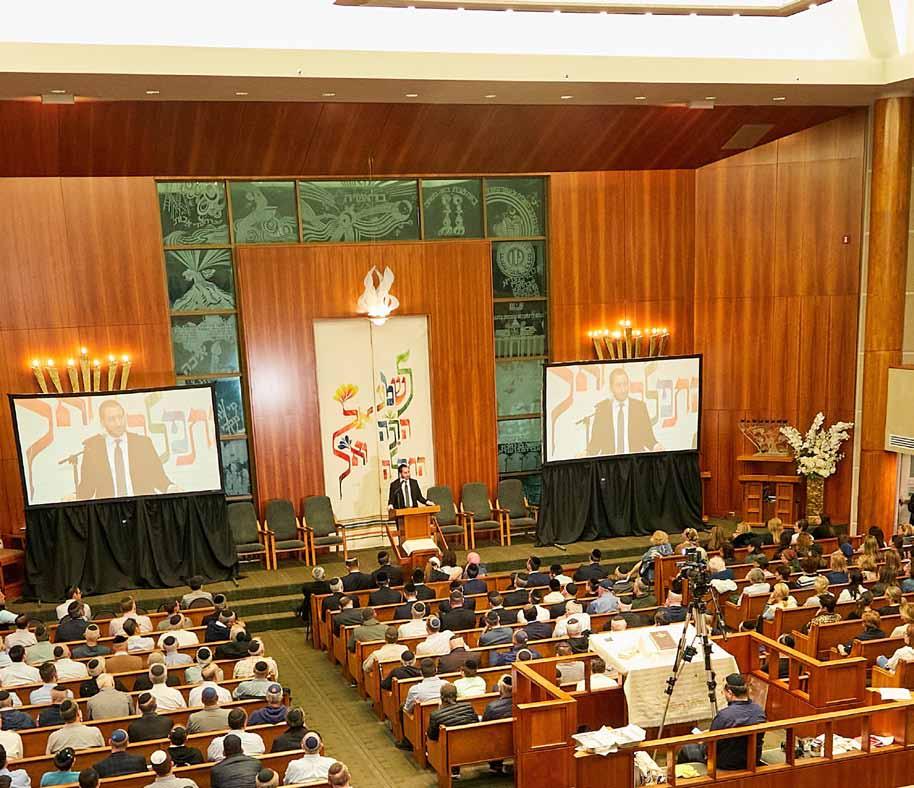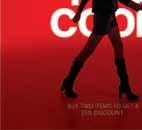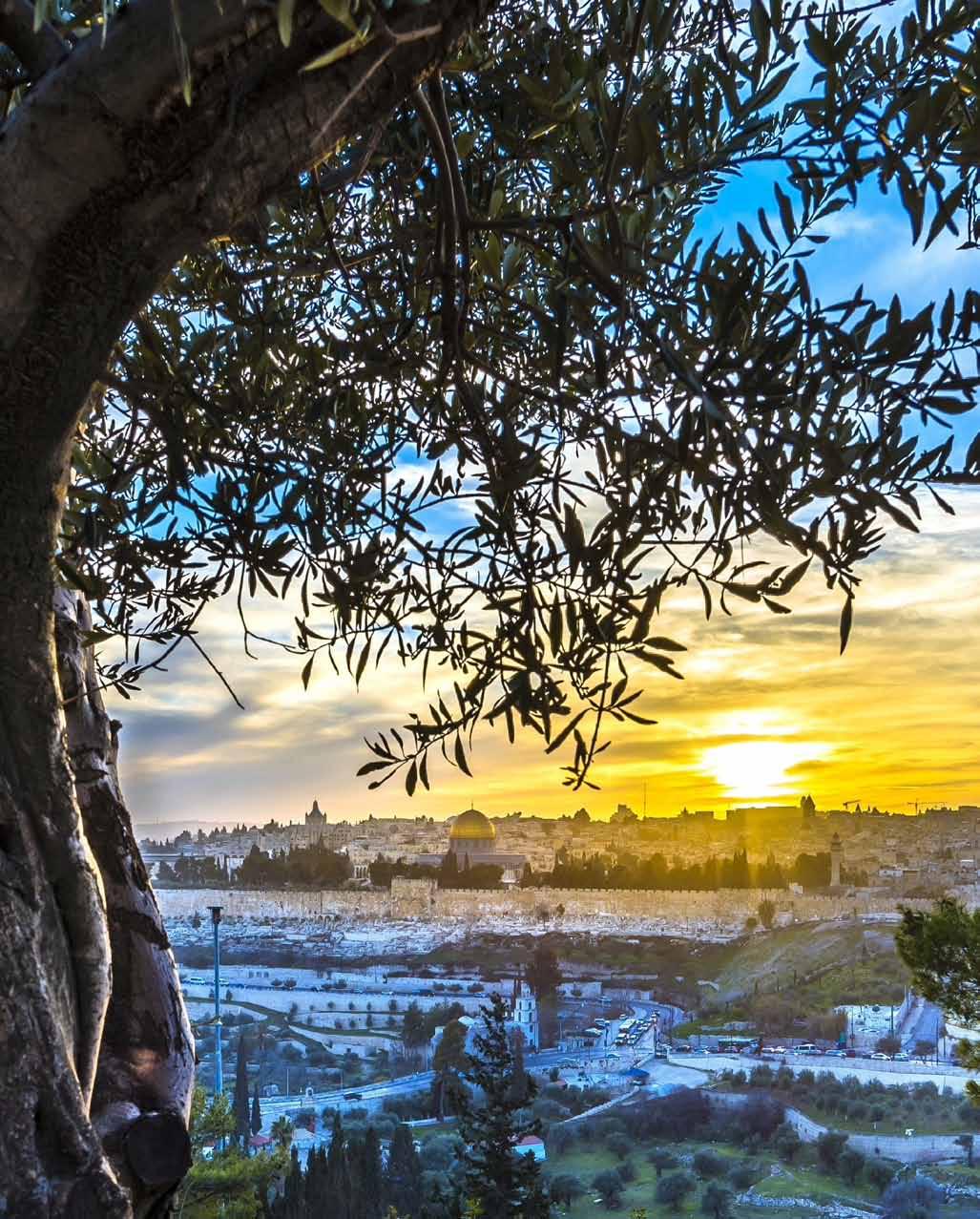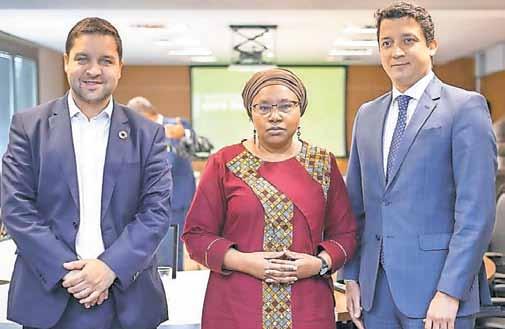




By Combined Sources
President Donald Trump vowed on Monday that “all hell is going to break out” if Hamas does not release the remaining hostages by Saturday.
Israeli Prime Minister Benjamin Netanyahu said on Tuesday that if the hostages are not released in line with Trump’s ultimatum, the ceasefire will expire and the IDF will resume fighting until it defeats Hamas totally.
“As far as I’m concerned, if all of the hostages aren’t returned by Saturday at 12 o’clock — I think it’s an appropriate time — I would say, cancel it and all bets are off and let hell break out,” Trump told reporters at the White House as he was signing a new round of executive orders.
“I’d say they ought to be returned by 12 o’clock on Saturday,” the president said. “And if they’re not returned — all of them, not in drips and drabs, not two and one and three and four and two — by Saturday at 12 o’clock. And after that, I would say, all hell is going to break out.”
After that time, Trump said, “it’s going to be a different ball game.”
Asked what “all hell will break out” means, Trump responded: “You’ll find out, and they’ll find out, too. Hamas will find out what I mean.”
“We want them all back,” Trump said. “I’m speaking for myself. Israel can override it.”



In a California public high school arts class, a conversation unfolded between students. One shared that his great-grandparent had been a Nazi while a Jewish teen revealed that her great-grandmother, now 103, had survived the Holocaust. When another student heard this, he remarked, “I guess his greatgrandfather didn’t complete his mission.”
Across the country, at a public high school on the East Coast, a math teacher’s personal choice of jewelry consists of a necklace with a Palestinian flag in the shape of a map of Israel and another necklace with watermelons on it.
•In an era where 91% of Generation Z obtain their news and world opinion from social media, we can’t afford to be passive about Jewish education and advocacy.
•When 60% of 14-year-old Jewish teens sympathize with Hamas, we’re failing our youth.
Yet there’s hope in these stark numbers. How? Education and empowerment.
These statistics demand immediate, decisive action. But instead of confronting these challenges head-on, our community is lost in debates about what to call our response.
•Is it “education” or “advocacy?”
•Are we “politicizing” our children or “empowering” them?
•Should we focus on “dialogue” or “action?”
While we parse these terms, our teens are learning to hide their identity in ways that should alarm us.
•They’re staying quiet about their trips to Israel.
•Some won’t even mention they’re Jewish in class discussions.
•They’re learning to make themselves invisible while we debate words instead of taking action. When African-Americans advocate for their civil rights, when LGBTQ+ individuals demand equal treatment and when women push for equality, we call it empowerment. Yet when American Jews stand up for themselves, many of us hesitate, excuse the bad behavior and even demand that these stand-up Jews
See To save our kids on page 2
Our teens are learning to hide their identity. They stay quiet about their trips to Israel. Some won’t mention they’re Jewish in class discussions. They’re learning to make themselves invisible while we debate words instead of taking action.
Continued from page 1
stop drawing attention to “their” issues. We’re stuck in a defensive crouch, reacting to each crisis instead of building generations of empowered, knowledgeable Jews who naturally stand tall.
For too long, we’ve confused advocacy with hasbara, a reactive defense of Israel that puts us perpetually on the back foot, explaining and justifying. But real advocacy isn’t about defending Israel’s latest policies or actions. It’s about American Jews standing up for themselves and confidently asserting their identity and rights.
Our established Jewish institutions are trying their best in a challenging landscape. Since Oct. 8, 2023, many have finally understood the problem and jumped in to address it.
Yet the outdated approach of separating education from advocacy feels increasingly disconnected from today’s reality. From Jewish day schools to youth movements to Jewish professionals in mainstream institutions, people still recoil at the word “advocacy.”
They think it’s just about Israel, but they are missing the urgent reality — our kids need advocacy skills just to walk around safely as Jews in America.
Our Jewish institutions have perfected the art of teaching the Holocaust while failing to prevent its modern incarnations. We’ve become experts at commemorating dead Jews while struggling to protect living ones.
This isn’t just misguided, it’s dangerously out of touch. It’s like watching someone in 1937 argue that teaching European Jews self-defense would somehow taint their religious studies. Without a deep understanding of who they are as Jews, their place in our people’s story and their connection to the Jewish nation, how can we expect our children to stand up for themselves?
The problem isn’t just institutional. Where are the parents in all this?
Too many are content to send our children to Jewish youth programs that prioritize “fun” programming over substance. When we leave teens to educate other teens, offering brief snippets of Jewish content between social activities, should we be surprised by the results we see?
We’ve become so skilled at teaching about Jewish persecution that we’ve forgotten to teach about Jewish power. And yet we’re shocked when they side with our persecutors in the name of social justice.
We celebrate when our teens attend Jewish gatherings that could be any secular club with a Hebrew name slapped on top. These programs might boost college applications and provide safe evening activities, but are we demanding they provide the education and empowerment our children desperately need? Are we satisfied with

a superficial Jewish identity wrapped in pizza parties and leadership titles?
Real empowerment isn’t born from slogans or PR campaigns. It comes from knowledge of our history, our peoplehood and our rights. It comes from skills, including public speaking, critical thinking and articulate writing.
When you know who you are and where you come from, when you understand your rights and have the tools to assert them, advocacy isn’t some extra activity — it’s a natural expression of your identity.
Rabbi Jonathan Sacks taught us a profound truth: When Jews act authentically as Jews, the world respects that. Yet somehow, we’ve convinced ourselves that advocacy is something separate from Jewish identity, as if standing up for our people is optional rather than essential to who we are.
We need to teach our children that speaking up for Jewish rights and dignity isn’t just a skill set — it’s part of what it means to be a Jew.
Just as we teach our children to pray, celebrate holidays and perform mitzvahs, we must teach them that advocating for their people is an integral part of their Jewish identity.
The artificial separation of Jewish education
from advocacy mirrors another false divide we’ve been subjected to — the notion that Zionism is somehow separate from Judaism itself.
Just as our 3,000-year connection to Zion is woven into our prayers, texts and daily lives, advocacy is intrinsically bound to Jewish education. They are three strands of the same cord as our Jewish identity naturally encompasses our connection to our homeland, our understanding of our heritage and our ability to stand confidently as Jews.
When we fragment each of these elements — treating Zionism as political, advocacy as confrontational and education as purely academic — we weaken the very foundation of Jewish identity.
The strength of our future generations depends on understanding that these aren’t separate choices but essential, interconnected parts of what it means to be Jewish in the modern world
This isn’t theoretical. We’ve seen it work. At Club Z, we’re proving this approach every day. By combining deep Jewish education with practical advocacy skills, we transform teenagers into confident, articulate leaders.
We understand that when you start with Jewish identity and historical literacy, support for Israel flows naturally — not as a talking point to be
said in a statement after the meeting.
In our pursuit of ‘nuance and complexity,’ we’ve lost sight of fundamental truths.
memorized but as part of who you are. The proof is in our results: Club Z teens don’t hide their identity or shrink from difficult conversations; they lead them.
Other minority groups understand this instinctively. They don’t apologize for teaching their children to stand up for themselves. They don’t create artificial barriers between education and empowerment. Their parents don’t settle for watered-down cultural programming. They expect equal treatment — no more, no less — and they make sure their children have both the knowledge and tools to demand it. Why aren’t we doing the same?
In our pursuit of “nuance and complexity,” we’ve lost sight of fundamental truths. While we debate shades of gray, our children face stark black-and-white realities in their classrooms every day.
•There is a right and a wrong.
•There is fact, and there is narrative.
•There is truth, and there are lies. Our obsession with nuance has become a paralytic, preventing us from taking the clear, decisive action our children need.
Return to those students in that California classroom. Imagine if the Jewish teen had been equipped not just with her greatgrandmother’s survival story but with the knowledge and confidence to respond effectively to that antisemitic taunt. Imagine if she had the tools to transform that moment from one of victimhood into one of education and strength.
And consider that math teacher on the East Coast, wearing symbols of hate disguised as political expression — what if every Jewish student in that class had the understanding to recognize these symbols and the advocacy skills to address such behavior appropriately through proper channels?
These aren’t hypothetical scenarios — they are the daily reality Jewish teens face. When we fail to combine education with advocacy training and hide behind complexity instead of standing up for what’s right, we’re sending these teens into battles armed with nothing but good intentions and vague cultural awareness.
The Holocaust survivor mentioned in our opening lived to see her great-grandchild face antisemitism in an American classroom. After 103 years, after everything she endured and survived, is this the legacy we want to leave? A generation of Jewish youth who must either hide their identity or face hatred without the tools to combat it?
Continued from page 1
“We all expressed outrage at the shocking state of our three hostages who were freed last Saturday,” Netanyahu said.
“Unless Hamas returns our hostages by noon on Saturday, the ceasefire will end and the IDF will resume intensive fighting until Hamas is totally defeated,” the prime minister’s statement concluded.
Aboard Air Force One on Saturday, Trump observed that the three men just freed “looked like Holocaust survivors. They were in horrible condition. … I don’t know how much longer we can take that.”
The president’s comments came after Hamas said it would delay the release of hostages scheduled
for Saturday “until further notice” due to alleged violations of the ceasefire agreement with Israel.
Israel estimates that Hamas still is holding 76 hostages, including 73 abducted during the terrorist attacks in southern Israel on Oct. 7, 2023.
During the current truce, which has lasted about three weeks, Hamas released 21 hostages.
Israel’s security cabinet on Tuesday fully endorsed Trump’s demand that Hamas release all of its hostages by noon on Saturday.
“The decision I passed in the Cabinet unanimously is this: If Hamas does not return our hostages by Saturday noon — the ceasefire will end and the IDF will resume intense combat until Hamas is decisively defeated,” Netanyahu
“In light of Hamas’ announcement of its decision to violate the agreement and not release our hostages, I instructed the IDF last night to amass forces inside and around the Gaza Strip. This operation is currently underway and will be completed as soon as possible,” he added.
The terror group accused Israel of shelling Gaza and not allowing sufficient supplies to enter the Hamas-run enclave. In response, Israeli Defense Minister Israel Katz said Hamas’ refusal to release the hostages would be an “outright violation of the ceasefire and that the country’s military should be prepared for the highest level of alert.”
Manwhile, as discussions continued over Trump’s statements regarding a US takeover of a depopulated Gaza, Netanyahu credited Trump for his “revolutionary vision for the future of Gaza, which we all welcomed.”
The time for half-measures and the careful separation between education and advocacy is long past.
Every day that we delay in the name of nuance, every moment we hesitate in the pursuit of complexity, is another day like that one in California, another classroom like that one on the East Coast. Every day we wait is another day we fail our youth, another day we dishonor the survival and resilience of generations before us.
The question isn’t whether advocacy belongs in Jewish education. The question is: How many more classroom incidents, how many more displays of hatred, and how many more hidden Jewish identities will it take before we accept that they are inseparable?
Masha Merkulova is executive director of Club Z. Write: Columnist@TheJewishStar.com



February is Jewish Disability Awareness and Inclusion Month.
Individuals with disabilities face societal challenges that extend beyond their own limitations. Whether they have physical, cognitive, sensory or psychological impairments, they confront workplace discrimination, inadequate accessibility, social stigma and patronizing treatment.
These barriers are often rooted in “ableism,” the discriminatory belief that people with disabilities have lesser abilities.
People with disabilities have different abilities. As former Knesset member Shai Piron says, “Some people’s challenges can be seen from the outside. That doesn’t mean they have
als with disabilities to absorb society’s negative perceptions. The result is low self-esteem, isolation and a lack of courage to advocate for oneself, creating a cycle that reinforces the very barriers they face.
Breaking this cycle requires decisive action. True participation of people with disabilities requires more than just awareness on our part.
We must fundamentally shift how we think, behave and act as a society. While we have made progress in recent decades, significant barriers still exist that prevent the full participation and acceptance of individuals with disabilities in our communities, workplaces, and social spaces.
Jewish Disability Awareness and Inclusion Month is a perfect time for us to commit to improving this issue as a society. Here are five essential steps to promote genuine inclusiveness and sensitivity:

specific teaching methods; promoting positive interactions between students with and without disabilities; and ensuring that children with disabilities have opportunities to develop their talents and leadership skills.
2. Challenge stereotypes and social stigma. We can each speak up against ableist
ship and public life. We can each encourage our community organizations to create programs that focus on building confidence, developing skills and fostering a positive self-image based on every individual’s strengths and abilities.
3. Reimagine accessibility as a fundamental right rather than an afterthought. Include individuals with disabilities to proactively consult with medical facilities, businesses and public spaces. Incorporate universal design

principles, as well as their input, into all new developments and recognize that accessible spaces benefit everyone in society.
4. Transform the workplace to embrace genuine diversity. Companies often hide behind superficial justifications for not hiring qualified candidates with disabilities, thus depriving businesses of talented individuals who bring unique perspectives and skills to the workplace. We can each encourage our own place of business to recruit from this talented pool of professionals while making necessary accommodations.
5. Promote authentic representation and selfadvocacy. We can all commit to actively trying to include people with disabilities in decision-making roles on policies and programs that affect their lives. When we create true partnerships between organizations and individuals with disabilities without paternalistic approaches, we foster true self-advocacy and enable services to be more ac-
curate for their clients.
Disability is an inherent part of human diversity that touches all communities. It can also become part of anyone’s life experience at any time. By creating a more inclusive and accepting environment, we will build a society that better serves those in a lifetime of need.
True inclusion isn’t about charity or compliance. It means recognizing and valuing human dignity, potential and the fundamental right of all individuals to participate fully in their communities and society as a whole.
When we make room to include challenges others have that we “see on the outside” we empower ourselves and everyone else to work with the challenges that are just as present in the rest of us, but perhaps are simply less seen.
Benny Hozmi is academic and knowledge resource director at Beit Issie Shapiro, an organization that works for to improve the quality of life for people with disabilities in Israel. Write: Columnist@TheJewishStar.com




































By David Isaac, JNS
The decree by the Palestinian Authority on Monday that it has restructured its terrorist payment program has been widely misrepresented as signaling the end of its pay-for-slay program, long-time observers told JNS, noting that reports of pay-for-slay’s demise are greatly exaggerated.
The announcement, published on the PA’s English-language WAFA news site, said the PA was transferring its payment allocation system from a ministry to an “independent” foundation.
It didn’t mention ending pay-for-slay, or what it calls its “Martyrs’ Fund,” in which Arabs, many of whom sit in Israeli prisons, are rewarded stipends for having carried out attacks against Jews.
Itamar Marcus, founder and director of watchdog group Palestinian Media Watch (PMW), told JNS of a telling exchange between Fatah, the ruling party of the PA, and Hamas.
Hamas, criticizing the move, said that Fatah, the ruling party of the PA, had abandoned the “martyrs.”
“Sons of the Homeland,” a Telegram channel used by Fatah’s Bethlehem branch, took umbrage at Hamas for publishing a “truncated version of the news” — that is, mispresenting the report to suggest that the PA was, in fact, canceling payments to terrorists.
Marcus quoted the Fatah-aligned channel: “The full news states that the salaries of the martyrs and printers have not and will not be affected, as all families that previously benefited from the law, regulations and systems will continue to be subject to the same standards.”
“Translation: the PA continues to fund and reward terrorism,” Marcus said.
Lt. Col. (res.) Maurice Hirsch, director of the Initiative for Palestinian Authority Accountability and Reform in the Jerusalem Center for Security and Foreign Affairs, told JNS that the PA is merely playing “a shell game, three-card monte, or if you will, three-card Mahmoud.”
The PA has tried pulling the wool over West-

ern eyes before, Hirsch said. In 2014, when the pay-for-slay program first made news and the PA felt that its funding was threatened, it declared that it was closing the Ministry of Prisons and no longer paying terrorist salaries.
“They announced it with great fanfare,” recalled Marcus. “What we saw internally was that they were opening in its place a PLO Commission of Prisoners. The Minister of Prisoners was going to be the Commissioner of Prisoners, and all the staff, all the buildings and the money were going to be the same but it wouldn’t be from the PA
“We’re all convinced something similar is happening now,” Marcus added, noting that Abbas is politically weak and Hamas is very popular because of its mass slaughter of Israelis. Abbas wouldn’t risk appearing to “hurt” the prisoners, he said. (Prisoner payments are extremely popular
among the Arab public in PA-controlled areas with 91% supporting them, according to a 2017 poll.)
Driving the timing of the PA’s announcement are a number of factors, the first of which is fear of liability.
It’s for this reason that the payment system is being transferred from a PA ministry to the so-called Palestinian National Economic Empowerment Foundation, described in the WAFA statement as an “independent legal personality.” Notably, it will be managed by a “board of trustees appointed by the president [Abbas].”
“They don’t want to be exposed to lawsuits in the States, and they would love to get the money that Israel is deducting in Israel,” Marcus said, referring to a 2018 Knesset law that ordered tax revenue Israel collects from the PA withheld to an amount equal to that which the PA pays to terrorists.
Hirsch agreed that the PA’s primary motive is to avoid liability, noting that the PA is reportedly seeking behind closed doors that the US repeal the Taylor Force Act, which cuts financial aid to the PA until it ends payments to terrorists and their families.
Also on the liability front, the US Supreme Court will hear an appeal in the coming months over whether the PA and Palestinian Liberation Organization can be sued in US courts, Hirsch said.
In 2015, plaintiffs were awarded $218.5 million, automatically trebled to more than $650 million under America’s Anti-Terrorism Act. (The sum amounted to a significant portion of the PA’s annual budget at the time — $4.2 billion.)
That decision was overturned by the 2nd Circuit Court of Appeals. But the US Congress has since changed the law. “They enacted the AntiTerrorism Clarification Act of 2018. which said that if you are a country or a body that receives U.S aid, you cannot deny jurisdiction in the courts,” Hirsch said.
In the last two weeks, a slew of amicus briefs were filed with the Supreme Court, Hirsch noted, “including a position from the Department of Justice supporting the law, saying that it is clearly constitutional and that the court should override the lower court’s decision.”
There have also been recent laws in Israel smoothing the way for suing terror sponsors, including one that went into effect in the summer of 2024 establishing compensation of 10 million shekels ($2.8 million) for someone murdered by terrorists and 5 million shekels ($1.4 million) for a person who suffered a disability due to terror.
“There has been a wave of lawsuits against the PA under that law,” Hirsch said.
As recently as Sunday, the Jerusalem District Court put a freeze on $760 million in PA funds following a lawsuit filed by hundreds of victims of the Oct. 7, 2023, Hamas attack.
The PA understands that the strategy of bankrupting terrorism is working, Hirsh said.
























































By Joshua Marks, JNS
Secretary of State Marco Rubio on Monday described Hamas as an “evil” and “monstrous” organization that must be wiped out.
During an interview on conservative talk radio channel SiriusXM Patriot, the top American diplomat condemned the terrorist group for its treatment of hostages.
“This is an evil organization. Hamas is evil. It’s pure evil. These are monsters. These are savages. That’s a group that needs to be eradicated,” he said.
He warned that its continued dominance in Gaza would prevent regional stability in the Middle East.
Rubio argued that the biggest challenge to a two-state solution is governance, and that peace is impossible if Gaza is controlled by terrorist groups committed to Israel’s destruction. He questioned why any nation would accept a neighboring state ruled by terrorists.
He also pointed out the extensive war damage in Gaza, including unexploded munitions, and highlighted that while President Donald Trump has proposed solutions, other regional leaders have yet to take meaningful action.
“And right now, the only one who’s stood up and said I’m willing to help do it is Donald Trump. All these other leaders, they’re going to have to step up,” he said.
“If they’ve got a better idea, then now is the time. Now is the time for the other governments

and other powers in the region, some of these very rich countries, to basically say, okay, we’ll do it. We’re going to pay for this; we’re going to step forward; we’re going to be the ones that take charge,” he added.
“None of them is offering to do it. And I think that you can’t go around claiming that you’re a fighter for, an advocate for the Palestinian people, but you’re not willing to do anything to help rebuild Gaza,” he continued.
“They’ll all tell you what they’re not for. But we’re still waiting for more countries to step forward and say here’s what we’re willing to do. And right now, they’ve not been willing to do anything … or at least anything concrete.”
Trump’s Gaza plan, he said, is a “challenge”
to these leaders.
“It’s outside the box, but that’s what he always is,” said Rubio. “I mean, he’s going to state the obvious. It’s the one thing about Donald Trump — he doesn’t hide behind silly, traditional lies and things of that nature.
“He’s going to put out blunt truth. And the blunt truth is that the Middle East has, for too long, been a region of places all of whom love to talk but don’t want to do. So, it’s time: If they don’t like Donald Trump’s plan, then it’s time for these countries in the region to step forward and offer their solution,” he concluded.
During a visit to Washington on Monday, Egyptian Foreign Minister Badr Abdelatty told Rubio that Arab states reject Trump’s Gaza plan,
which includes resettling Gazans while the coastal enclave is rebuilt and deradicalized.
According to Reuters, Abdelatty emphasized the need for Gaza to be reconstructed while ensuring Palestinians remain there.
The Egyptian Foreign Ministry issued a statement following the meeting stating that Cairo “adheres to the right of the Palestinian people to return to their homeland, to self-determination, and to establish an independent state.”
According to the readout of the meeting provided by State Department Spokesperson Tammy Bruce, Rubio “thanked the Foreign Minister for Egypt’s mediation efforts in securing the release of hostages, for sustaining humanitarian assistance deliveries throughout Gaza, and accepting medical evacuations.”
The statement went on to say that “the secretary reiterated the importance of close cooperation to advance post-conflict planning for the governance and security of Gaza and stressed Hamas can never govern Gaza or threaten Israel again.”
Abdelatty also met with US special envoy to the Middle East Steve Witkoff to discuss regional stability.
Meanwhile, after Hamas announced the delay of the next scheduled hostage release “until further notice,” Trump vowed on Monday that “all hell is going to break out” if Hamas did not release the remaining hostages by noon on Saturday.
The president also indicated that he might withhold aid from Egypt and Jordan if they refuse to accept Palestinian refugees from Gaza.
In January, the president called on Arab nations, specifically Egypt and Jordan, to take in more Palestinians to “clean out” the Gaza Strip. King Abdullah II of Jordan and Egyptian President Abdel Fattah el-Sisi have repeatedly rejected that plan.
On Tuesday, Trump hosted Abdullah at the White House.

At The Jewish Star, selling advertising for the newspaper is just part of the job.
Our staff’s toolkit includes an exceptionally broad range of useful products (including both religious and secular publications and websites; digital, email, radio and social media marketing; in-person events; direct mail; commercial printing, and more) — whatever it takes to build business and raise revenue for our commercial and non-profit partners.
Employees are trained by the best in the business, in a supportive, collegial and kosher environment.
These F/T positions (P/T schedules may be arranged) offer competitive compensation ($40k-$90k) with excellent commission and bonus opportunities, paid holidays (including Jewish holidays), time off, medical and 401(k).

In 1993, Anita Rothenberg of Valley Stream was first admitted to Mount Sinai South Nassau’s ER in Oceanside and treated for a heart attack at the age of 37. She recovered, raised a family and worked as a teacher on Long Island for the next 29 years. Then, in November of 2022, an angiogram showed three blocked arteries. She underwent triple bypass surgery a few days later at Mount Sinai Fuster Heart Hospital in Manhattan and completed her cardiac rehabilitation close to home at Mount Sinai South Nassau.
Mount Sinai South Nassau o ers comprehensive heart care for Long Islanders, and has received the following ratings and quality awards:
• Rated High Performing in heart attack and heart failure from U.S. News & World Report ® for 2024-2025
• Healthgrades America’s 100 Best Hospitals for Coronary Intervention™
• Healthgrades Coronary Intervention Excellence Award™
• Healthgrades Five-Star Recipient for Coronary Interventional Procedures
• Named among the top five percent in the nation for Coronary Interventional Procedures by Healthgrades
L ea rn mo re a t mountsinai.org/southnassauheart
JonAthAn
S. toBin
JnS Editor-in-Chief

New England Patriots owner Robert Kraft is an exemplary member of the American Jewish community. Over the years, he has donated a great deal of money to Jewish causes, locally in his hometown of Boston and in the State of Israel, even building a football stadium in Jerusalem. The National Football League magnate’s philanthropy testifies to his own strong sense of Jewish peoplehood, in addition to a decent concern for others less fortunate than himself, as shown by his family’s support of a variety of educational and health-care causes.
Among the efforts he has supported is the Foundation to Combat Antisemitism (FCAS), which he founded with money he pledged as a result of his winning the Genesis Prize in 2019. The idea behind the foundation was to fight the movement to boycott, divest and sanction Israel, as well as other efforts to battle Jew-hatred. The campaign itself was marked by a bright blue square with a moniker called “The Blue Box Campaign” that urges standing up to hate.
But for all of his various efforts on behalf of that important cause, probably none gained as much attention as the FCAS advertisement that appeared during the Super Bowl this past Sunday.
It featured two mega-celebrities — rapper and actor Snoop Dogg, and NFL great Tom Brady, who won seven Super Bowls, including six for Kraft’s Patriots. In it, they spout various reasons why people hate each other before concluding that “things are so bad that we have to do a commercial about it,” before the two walk off together in a gesture of amity.
Though it was sponsored by an organization specifically aimed at combating antisemitism, at no point in the 30-second advertisement, which cost Kraft’s group $8 million to purchase, was the word mentioned. Nor were the words Jew or Jewish.
That’s a colossal mistake, as well as a missed opportunity that Kraft and anyone else who cares about the issue should deeply regret.
While no one should doubt the good intentions of Kraft, the 30-second blurb sums up everything that is wrong with the mindset and the efforts of liberal American Jewish efforts to deal with the problem.
Indeed, if that’s the best that the FCAS can manage, then Kraft would be well advised to close it up and transfer the money he’s currently wasting on it to those interested in fighting antisemitism in a way that will make a difference.
Part of the problem was the employment of Snoop Dogg. While he may be famous and a ubiquitous figure in pop culture and ads for all sorts of products, he’s also a well-known antisemite. As the Americans for Peace and Tolerance group noted in its criticism of the ad, he is an avowed supporter of the antisemitic Nation of Islam group and its 91-year-old leader, Louis Farrakhan, who has done more than anyone to spread Jew-hatred among American blacks and Muslims. Using him in a spot sponsored by a group that cares about antisemitism wasn’t mere negligence but a betrayal of the values Kraft has always exemplified.
Robert Kraft’s Foundation to Combat Antisemitism wasted $8 million on a commercial that never mentioned Jews or antisemitism.
There was more that was wrong about it other than Snoop Dogg.
The underlying premise was a decision to try to universalize the problem rather than one that would specifically focus on the issue of antisemitism. That’s based on an assumption that talking about antisemitism and Jews is a turnoff to a broad audience like the one that tunes into the Super Bowl.
The NFL championship game is the most watched television program every year — an event that has assumed the status of a secular holiday. This year’s show reportedly attracted an average audience of 126 million viewers throughout the contest with a peak of 135.7 million watching, with the halftime show featuring rapper Kendrick Lamar being a major draw.
Wisse has noted, the most successful ideology of modern times since it has attached itself to a variety of movements, including fascism, communism, socialism, Islamists, and in our own day in contemporary America, woke ideologues who pretend to be “anti-racists.” The latter claims to be defending minorities against Jews who are “white” oppressors, as part of a struggle against racism that can never end.
And, just as was true of the German Nazis and their collaborators, anything can be justified if it constitutes “resistance” to the Jews or the Jewish state, even the atrocities of Oct. 7, 2023, committed by the Hamas terrorist group and other Palestinian Arabs.
That is why rather than provoking sympathy for the Jewish state and Jews around the world,

With that in mind, the FCAS produced an ad that it supposed would appeal to the widest possible audience and therefore went all-in on universalizing the problem.
This is the same premise of most Holocaust education programs that have been employed in the United States in the past few decades. They are rooted in the belief that the only way anyone can be deterred from hating Jews is to depict the Holocaust and antisemitism as essentially no different than any other form of prejudice. In this way, as the FCAS ad seemed to be telling us, Jewhatred is no different from disliking any group or people other than the majority.
The solution, then, is for everyone to play nicely with each other the way Snoop and Brady — a black celebrity and a white one — appear willing to do.
But if history, as well as the present-day surge in Jew-hatred teaches, it is that antisemitism is not like other varieties of prejudice, be they major or minor. It is a specific virus of hate that targets Jews not merely as a function of bad behavior or a lack of awareness of our common humanity, but as a means of acquiring and holding onto political power.
To antisemites of every variety — be they left-wing, right-wing, Islamists, and yes, blacks — Jews aren’t merely the “other.” They are in the crosshairs to be despised and subjected to singular prejudice and discrimination, no matter their age, background, what they do or where they reside. They are, instead, an almost superhuman force for evil that must be eradicated. They alone are to be denied rights that even other discriminated minorities are given. And in so doing, various groups can wield power and pretend to be forces for good.
Why antisemitism spreads
That is why antisemitism is such a contagious and adaptable virus. It is, as scholar Ruth
mass murder of Jews and destroy the one Jewish state on the planet is the sort of thing that friends should be willing to agree to disagree over rather than a patently evil cause.
As depressing as it is for a civil-rights-era veteran to write such things, it’s equally true that he — and those who might agree with him — is an ally not worth having.
But we’ve also seen why the timid universalizers of the FACs are dead wrong about the American people.
Contrary to the stereotypes spread by the political left, the American people as a whole are not antisemitic. Nor are they irredeemably racist against blacks, Hispanics or other minorities. And, as the election results last November showed, they don’t much appreciate the lectures of sermonizing liberals who talk down to them, and think that their patriotism and most cherished values and beliefs are racist or expressions of prejudice.
The universalizing of the battle against antisemitism plays right into the lies of the most prevalent form of American bigotry against Jews.
It is true that the last 16 months of brazen antisemitism and the mainstreaming of efforts to rationalize and even justify it in the mainstream liberal corporate media have presented new and unique challenges for Jews.
But the response of most Americans, which is to say that those who live outside the woke leftist bubble in which much of the press and other cultural elites live, is support for Israel and anger at students and other activists who chant for the genocide of Jews (“from the river to the sea”) and terrorism against them (“globalize the intifada”). President Donald Trump may only have the support of the approximate half of the electorate that voted him into office. But he speaks for the vast majority of the country that supports Israel and believes that foreigners who use their student visas to engage in anti-Israel (and anti-American) protests, encampments and often violent-like behavior should be deported.
the Oct. 7 spree of mass murder, torture, rape and kidnapping in southern communities in Israel inspired an unprecedented surge in antisemitism.
In the face of such ideological fanaticism, merely telling people to be nice — as that Super Bowl ad did — does nothing. Such universalization trivializes the Holocaust. The same can be said for efforts that treat the widespread rationalization and even defense of antisemitic acts of intimidation and violence on American college campuses.
What makes this particularly disappointing is that last year’s FCAS Super Bowl ad was not so wrongheaded. Their 2024 featured Clarence B. Jones, a former speechwriter for Dr. Martin Luther King Jr. speaking against generic hate.
The images that appeared on the screen while he spoke were specific in that they showed swastika graffiti on Jewish institutions and signs that spoke of the need to fight antisemitism. It left no doubt of the particular problem that, only a few months after Oct. 7, as Jew-hatred spread on campuses and in the streets of major U.S. cities, the country was facing.
Interestingly, since then Jones has broken with Kraft and the FCAS over what he depicts as insufferable Jewish “demands for loyalty.” Sadly, like many in the African-American community, he seems to think that a request to support the struggle of the Jewish people against the genocidal Islamists of Hamas is a bridge too far.
In a USA TODAY op-ed in which Jones vented his resentment against his former allies, he blamed the refusal of Israelis and their American Jewish supporters for the collapse of the alliance between blacks and Jews that flowered during Dr. Martin Luther King Jr.’s time. In doing so, he not only embraces classic tropes of antisemitism like dual loyalty but also seems to think that Hamas’s efforts to accomplish the
Jews and the groups that purport to speak for them as well as to lead the fight against antisemitism like Kraft’s FCAS ought not to buy into the idea that America is full of hate. In this way, the Super Bowl ad was just another version of those ubiquitous lawn signs that say “Hate Has No Home Here,” as if to imply that those who don’t engage in such liberal virtue signaling, are haters.
Trump, whose executive orders against antisemitism and full-throated support of Israel aren’t couched in amorphous platitudes like that of the 2025 Super Bowl ad, has had no trouble in identifying the sources of the current surge in antisemitism. Like him, they ought to be exposing the Jew-haters, and countering lies about Israel and the Jewish people that are integral to the left’s toxic myths of critical race theory, intersectionality and the woke catechism of diversity, equity and inclusion (DEI) that are the root of the problem.
If they did, they might find that most Americans don’t need to be shamed into uniting against antisemitism but would, instead, readily support an unapologetic campaign to back Israel and join the fight to roll back the woke tide fueling much of contemporary American antisemitism.
This Super Bowl ad will soon be forgotten. But the decision to run something like it demonstrates just how clueless even well-meaning establishment figures like Kraft are when it comes to the world’s oldest form of prejudice. It’s a reminder that rather than relying on legacy groups and celebrity-driven foundations like that of Kraft, it is long past time to get rid of such organizations and pour Jewish philanthropic dollars into the hands of those able to think clearly about the problem. Jews need to stop their reflexive desire to universalize their tribulations, and even more, to stop blaming all of the American people for the transgressions of leftist elites.
Write: Columnist@TheJewishStar.com

are Jews. The indigenous people of the land of Israel. We are Zionists. At home in Zion (Jerusalem) in Midinat Yisrael.

Type 2 diabetes is on the rise. The reasons are numerous; some experts say that high fructose corn syrup is to blame, others that statin drugs have caused a spike, most say that the food choices we make are to blame.
I am NOT a nutritionist, but I have learned a lot from several that I consult on occasion, and I have learned to be aware of those foods that cause trouble.
Sadly, these foods are the ones that we all love and even crave as comfort foods — chocolate chip cookies, pasta, soft white breads, warm Sunday bagels, creamy ice cream, Oreos, chips, brownies. In addition, each year, almost 20,000 new, mostly processed food items, are placed on store shelves; thousands of food choices that are the enemy when it comes to choosing a diet that will help avoid this life-altering and life-threatening illness.
If you have diabetes, you know the drill. If you do not have diabetes, you still need to watch your intake of white foods and sugary treats. And we have to do a better job of teaching our children.
In America, unlike in other countries, we have trained our kids to have a “sweet palate,” preferring ice cream to kale or spinach. However, we can help our children learn to like healthier foods and make good food choices. We can raise a new generation of healthier kids who won’t face this illness as adults just by making some wiser food choices for them and for ourselves.
(Meanwhile, consult with your doctor or nutritionist about any issue you may have regarding dietary choices and watch for the warning signs such as excessive thirst or urination, blurry vision or rapid, unexplained weight loss.)
The following foods and recipes can be part of a delicious, glucose-healthy diet.
Fish is good for everyone, but is especially good for diabetics. It is low in calories and fat and tastes delicious. You can use any fruits you like with this dish and make it as sweet or not, as you like.
• 1-1/2 to 2 lbs. (1-inch thick) thick, firm fish such as halibut, cod or salmon
• 1 Tbsp. extra virgin olive oil
• Salt and pepper, to taste
• 1/2 to 1 cup chopped fresh pineapple
• 1/2 to 1 cup rinsed, drained blackberries
• 1 to 2 Tbsp. chopped fresh cilantro, parsley, chives or basil (optional)
• 1/2 to 1 cup fresh orange segments, (grapefruit is OK if you are not taking a Statin drug)
• 1/3 cup raspberry vinegar, more or less, to taste
• 1 to 2 Tbsp. agave syrup, honey or equivalent sweetness in a sugar substitute, to taste
OPTIONAL: Pinch cayenne pepper or red pepper flakes for a bit of heat. Preheat broiler to medium or oven to 425. Rub fish with oil. Place on a greased, foil-lined, rimmed baking dish and season with salt and pepper. Broil or bake until desired doneness. While the fish is cooking, place the pineapple, blackberries, cilantro and orange segments in a bowl and mash a bit with a fork to release some of the juices from all the fruit.

Add the vinegar and sweetener and taste. Adjust to your liking, adding more vinegar or sweetener as desired. Mix well. Place a piece of fish on each of 6 plates and top with the fruit. Or, if you like, place it over the fish for the last 3 to 5 minutes of cooking. Serves 4 to 6.
Zucchini is a good addition to any diet because, besides being available year-round at a relatively low cost, it is easily used in everything from salads to main dishes to desserts. It is very low calorie and high in folate, an essential B vitamin and Vitamin A.
• 1 Tbsp. extra virgin olive oil
• 1 onion, diced
• 1 to 3 cloves garlic, finely minced
• 2 small zucchini cut into 1/4-inch-thick slices and slices cut in half
• 1 can (15 ounces) diced tomatoes
• 1 can (13 ounces) chickpeas, drained and rinsed
• Several fresh basil leaves, rolled and cut into thin strips (chiffonade) or 1/2 tsp. dried
• Several fresh thyme leaves cut as above, or 1/4 tsp. dried
• Any of your favorite herbs
• Salt and freshly cracked black pepper to taste
OPTIONAL: Freshly grated low-fat cheese or grated Parmesan
Heat oil in a medium-size skillet over medium heat. Add onion and sauté until golden, about 5 to 7 minutes. Add the garlic and mix until fragrant. Add the zucchini and cook until softened, about 3 minutes, stirring almost constantly. Add the tomatoes and chickpeas and mix well. Let simmer for about 3 to 4 minutes. Add the basil and thyme, salt and pepper, mix well and cover. Simmer for about 5 to 7 minutes, mixing once or twice. Remove cover and cook an additional 3 to 4 minutes. Taste and adjust seasonings. You can top with some grated low fat cheese or Parmesan. Serves 6.
Lentils are good for diabetics because they are loaded with healthful nutrients, are low fat, high in protein and high in fiber at 8 grams a serving. Add some delicious butternut squash and some seasoning and you have the makings of great, light chili.
• 1 Tbsp. canola oil
• 4 to 8 cloves garlic, finely minced
• 1 onion, diced
• 1 to 2 Tbsp. chili powder, to taste
• 32 oz. (low-sodium if you like) vegetable broth
• 3/4 cup dried brown or green or red or mixed lentils, rinsed and any debris removed
• 1 to 2 tsp. smoked chipotle hot pepper sauce or tabasco sauce, to taste
• 2 cups peeled and cubed butternut squash
• 1 can (about 14 to 15 ounces) diced tomatoes (low-sodium or salt free)
• Chopped fresh cilantro, to taste
• Optional: Fat-free sour cream
• Toasted Pepitas (pumpkin seeds)
Heat the oil in a large saucepan and add the onion, sauté until golden and add the garlic. Cook about 30 seconds and add the chili powder. Mix for about 30 seconds.
Slowly add the vegetable stock and bring to a simmer. Add the lentils and bring to a boil over high heat. Reduce heat to low, add the hot pepper sauce, to taste and cover. Simmer for about 15 minutes. Add the squash and tomatoes and simmer for about 20 to 30 minutes until most of the liquid is absorbed and the squash and lentils are tender.
Garnish with cilantro, fat-free sour cream and pepitas, if desired. Serves 4.
Use any color pepper and fill with lean hamburger meat, ground turkey, chicken or meat
substitute like seitan or tofu. You can go completely veggie and add some cheese. Very versatile.
• 2 Tbsp. extra virgin olive oil
• 1 large onion, diced
• 2 to 4 cloves garlic, finely minced
• 1 tsp. extra virgin olive oil (additional)
• 1 to 2 tsp. tomato paste
• 6 oz. lean ground hamburger meat, ground turkey, ground chicken, seitan, or cubed tofu
• 1 cup diced tomatoes, fresh or canned, drained
• 1 cup cooked brown rice
• Crushed red pepper flakes
• Herbs and spices such as cumin, oregano, parsley, chives, cilantro, paprika, to taste
• Salt and freshly cracked black pepper, to taste
• 2 large bell peppers, cut in half stem to flower end, seeds and white membrane discarded
Preheat the oven to 400 degrees. Heat a large skillet, add the olive oil and the onion and sauté until golden. Add the garlic and mix for about 30 seconds. Make a space in the middle of the pan and add a teaspoon of olive oil. Place the tomato paste on the olive oil and let it sizzle for about 10 seconds. Mix into the onions. Add the meat and mix to break up any clumps. Cook until cooked through. Add the diced tomatoes and mix well. Add the rice and mix well. Season as desired and fill the four peppers. Place in a roasting pan and add about 1/2 cup of water to the pan. Place the peppers in the pan and cover tightly with foil. Roast for about 45 minutes, removing the foil for the last 10 minutes. Serves 4.
Note: Studies have shown that as little as 1/2 teaspoon of cinnamon a day can help control blood sugar and 1 teaspoon of cinnamon has more antioxidants than a full cup of pomegranate juice. I mix 1 tsp. of cinnamon with 1 packet of sugar substitute and sprinkle it on some low fat cottage cheese or steel cut oats for a delicious breakfast.



































































Not all barbarians dress like terrorists. That was what kept running through my mind as I wandered last week through the world premiere of “Anne Frank, The Exhibition” at the Center for Jewish History in New York.
Opening on International Holocaust Remembrance Day on Jan. 27, which this year was the 80th anniversary of the liberation of Auschwitz, it’s the first full-scale replica of Anne Frank’s annex.
The 7,500-square-foot, multimedia installation was created by the Anne Frank House in Amsterdam in collaboration with the history center. While the annex remains empty of original Frank family items (at Otto Frank’s request), the reconstruction contains more than 100 original artifacts — furniture, friendship albums, correspondence, a Torah — from the eight Jews who hid there for two years from July 1942 to August 1944.
The installation, which will be up through April 30, traces the Frank family from the 1920s in Frankfurt, Germany, through their flight to Amsterdam in 1934. Visitors explore five shadowy rooms, whose exact dimensions were copied from the annex — down to the covered windows and bits of peeling wallpaper. A map of Europe, glowing beneath a glass floor, depicts the locations of every concentration camp, and every site of genocide is marked with a small flag.
The array of signs in Dutch prohibiting Jews from entrance — “No entry for Jews,” “Jews forbidden,” “Jews not allowed” and “Jews not Dutch” — is particularly jarring.
After being deported, Anne and her older sister, Margot, died of typhus in the Bergen-Belsen concentration camp just

months before the end of the war in Europe in May 1945. Of the eight Jews who hid in the annex, only Otto Frank survived.
Miep Gies, who had assisted the group with food and other support during their time in hiding, had preserved Anne’s writings and shared them with him. A Dutch publisher first released a version of the diary in 1947.
The exhibition also includes displays of 79 published editions of Anne Frank’s “The Diary of a Young Girl,” which has been translated into dozens of languages and sold more than 30 million copies.
Otto Frank had requested that the spaces of the annex, plundered by the Nazis, remain vacant — their barrenness attesting to the murder of 75% of Dutch Jews. One could take issue with the re-creation, just as one could take issue with publishing the full diary against his wishes.
But after Oct. 7, 2023 — the worst massacre of
Jews since the Holocaust — when many seemingly intelligent people refuse to see it as such, one imagines that Otto Frank would be focused on getting as many people to see it as possible. More than 250 school tours have already been booked.
At the same time, one can’t help but point out the fact that the original annex admits 1.2 million visitors annually, while Amsterdam these days is boiling with antisemitism.
Which brings us back to the fact that not all barbarians dress like terrorists. I do believe that part of the shock of the post-Oct. 7 reaction stems from our own forgetting of centuries of preHamas persecution.
After the trial of Adolf Eichmann in Jerusalem in 1961, Hannah Arendt coined the phrase “the banality of evil” to describe how ordinary people can commit evil acts by “just following orders.” Her thesis was that evil can become banal when it’s systematic and unthinking — when ordinary people participate in it without care or choice.
Arendt was admonished for her book, and in my opinion, rightly so. One just has to look at the photos of well-dressed Germans savagely and gleefully beating Jews in the streets or the films shot by British and American soldiers upon liberating the camps to see the superficiality of her theory.
The soldiers found corpses with eyes gouged out, bodies split open and remnants of barbaric experimentation. Even more telling, when soldiers took groups of “ordinary” Germans to see the camps for themselves, the expressions on their faces were often not of horror but of complacency.
Germans at the time considered themselves highly educated. But education doesn’t necessarily track with civilized behavior; Marxists also consider themselves highly educated. The fact is, the “good German” is a myth. The only good Germans were the ones who hid Jews and otherwise helped save Jews, not the ones “following orders.”
While this exhibition commemorates the worst genocide in history, it also helps to explain how contemporary “educated” leftists can refuse
to understand what the word genocide means, even as they try to repeat it. And in Europe, there’s a good chance that the grandparents of today’s violent rioters were herding humans into gas chambers 80 years ago.
Some Germans took their own lives so they wouldn’t be forced to perform barbaric acts on innocents. Sadly, that’s one of the few civilized responses to evil. It’s a response we never hear about in the Islamic world. This set of enemies has been taught since birth to hate and kill Jews as they believe it’s religiously sanctioned.
Sophie Scholl, a student leader of the White Rose resistance group during the Holocaust, was also religiously motivated to do everything possible to alert the world to what the Nazis were doing.
“Laws change,” she said. “Conscience doesn’t.”
Scholl faced the Nazi guillotine for telling the truth. She was only a few years older than Anne Frank.
Anything that excuses barbarism in any of its forms merely mocks the righteousness of those who live their lives doing good deeds and bravely calling out evil.
It’s not pleasant to think that gleeful savagery will no doubt return with every generation. But understanding this truth is the only way to move forward.
Karen Lehrman Bloch of White Rose Magazine.
Write: Columnist@TheJewishStar.com
Today’s ‘educated’ leftists
refuse
to understand
what the word genocide means, even as they try to repeat it.
DESK of RABBI S.M. LEINER- INSURANCE
Note the ACCOLADES from our CLIENTS
RE: SYNAGOGUES and YESHIVOS
Dear Rabbi Leiner, Thank you for replacing the Insurance for our Synagogue, with a Savings of almost 50%.
B.F. Executive Director
RE: REAL ESTATE CORPORATION
Dear Rabbi Leiner, You and Your Experts, have saved our Corp. Very Substantial Sums, with your Quality Insurance Replacement on our Real Estate Buildings. Thank you, M.B. Pres.
RE: HOMEOWNERS INSURANCE
Dear Rabbi Leiner, Our Insurance Company Refused to renew our Insurance Homeowners Policy. However, You and Your Experts were able to Secure for us other Insurance Coverage, even at a much lower Premium, than the Prior Canceled
Thank You So Much. Mrs. D.S.
Jewish Star Torah columnists:
•Rabbi Avi Billet of Anshei Chesed, Boynton Beach, FL, mohel and Five Towns native •Rabbi David Etengoff of Magen David Yeshivah, Brooklyn
•Rabbi Binny Freedman, rosh yeshiva of Orayta, Jerusalem
Contributing writers:
•Rabbi Sir Jonathan Sacks zt”l,
former chief rabbi of United Hebrew Congregations of the British Commonwealth •Rabbi Dr. Tzvi Hersh Weinreb, OU executive VP emeritus •Rabbi Raymond Apple, emeritus rabbi, Great Synagogue of Sydney •Rabbi Yossy Goldman, life rabbi emeritus, Sydenham Shul, Johannesburg and president of the South African Rabbinical Association.
Contact our columnists at: Publisher@TheJewishStar.com
Five Towns Candlelighting: From the White Shul, Far Rockaway, NY
Fri Feb 14 / Shevat 16
Yisro Candles: 5:10 • Havdalah: 6:20
Fri Feb 21 / Shevat 23
Shabbos Mevarchim • Mishpatim Candles: 5:18 • Havdalah: 6:29
Fri Feb 28 / Shevat 30
Rosh Chodesh Adar (Fri and Sat)
Shekalim • Terumah
Candles: 5:27 • Havdalah: 6:37
Fri March 7 / Adar 7
Tetzaveh • Shabbos Zachor
Candles: 5:34 • Havdalah: 6:44
Fri March 14 / Adar 14
Ki Sisa (Fri is Purim, Sat is Shushan Purim) Candles: 6:42• Havdalah: 7:52
Fri March 21 / Adar 21
Shabbat Parah • Yayakhel) Candles: 6:49 • Havdalah: 7:59

There’s an enthralling story about the Ten Commandments and the role they played in Jewish worship and the synagogue. It begins with a little-known fact. There was a time when there were not three paragraphs in the prayer we call the Shema, but four. The Mishnah in Tamid (5:1) tells us that in Temple times the officiating priests would first recite the Ten Commandments and then the three paragraphs of the Shema.
We have several pieces of independent evidence for this. The first consists of four papyrus fragments acquired in Egypt in 1898 by the then secretary of the Society of Biblical Archaeology, W.L. Nash. Pieced together and located today in the Cambridge University Library, they are known as the Nash Papyrus. Dating from the second century BCE, they contain a version of the Ten Commandments, immediately followed by the Shema. Almost certainly the papyrus was used for prayer in a synagogue in Egypt before the birth of Christianity, at a time when the custom was to include all four paragraphs.
Tefillin from the Second Temple period, discovered in the Qumran caves along with the Dead Sea Scrolls, contained the Ten Commandments. Indeed a lengthy section of the halachic Midrash on Deuteronomy, the Sifri, is dedicated to proving that we should not include the Ten Commandments in the tefillin, which suggests that there were some Jews who did so, and the rabbis needed to be able to show that they were wrong.
We also have evidence from both the Babylonian Talmud (Bavli, Brachot 12a) and the Jerusalem Talmud (Yerushalmi Brachot 1:8) that there were communities in Israel and Babylon who sought to introduce the Ten Commandments into the prayers, and that the rabbis had to issue a ruling against doing so.
There is even documentary evidence that the Jewish community in Fostat, near Cairo, kept a special scroll in the Ark called the Sefer al-Shir, which they took out after the conclusion of daily prayers and read from it the Ten Commandments.
So the custom of including the Ten Commandments as part of the Shema was once widespread, but from a certain point in time it was
Attempts by the Sages to avoid giving special dignity to the Ten Commandments were overcome.
systematically opposed by the Sages. Why did they object to it? Both the Babylonian and Jerusalem Talmud say it was because of the “claim of the sectarians.”
Jewish sectarians — some identify them as a group of early Christians but there is no compelling evidence for this — argued that only the Ten Commandments were binding, because only they were received by the Israelites directly from G-d at Mount Sinai.
The others were received through Moses, and this sect, or perhaps several of them, held that they did not come from G-d. They were Moses’ own invention, and therefore not binding. There is a Midrash that gives us an idea of what the sectarians were saying. It places in the mouth of Korach and his followers, who rebelled against Moses, these words:
The whole congregation are holy. Are you [Moses and Aaron] the only ones who are holy? All of us were sanctified at Sinai … and when the Ten Commandments were given, there was no mention of challah or terumah or tithes or tzitzit. You made this all up yourself. Yalkut Shimoni Korach 752
So the rabbis were opposed to any custom that would give special prominence to the Ten Commandments since the sectarians were pointing to such customs as proof that even orthodox Jews treated them differently from the other commands. By removing them from the prayer book, the rabbis hoped to silence such claims.
But the story does not end there. So special were the Ten Commandments to Jews that they found their way back. Rabbi Jacob ben Asher, author of the Tur (14th century) suggested that one should say them privately.
Rabbi Joseph Karo argues that the ban only applies to reciting the Ten Commandments publicly during the service, so they could be said privately after the service. That is where you find them today in most siddurim — immediately after the morning service. Rabbi Shlomo Luria had the custom of reading the Ten Commandments at the beginning of prayer, before the start of Pesukei de-Zimra, the Verses of Praise.
That was not the end of the argument. Given that we do not say the Ten Commandments during public prayer, should we none the less give them special honor when we read them from the Torah, whether on Shavuot or in the weeks of Parshat Yitro and Vaetchanan? Should we stand when they are being read?
Maimonides found himself involved in a controversy over this question. Someone wrote him a letter telling the following story. He was a member of a synagogue where originally the custom was to stand during the reading of the Ten Commandments.
Then a rabbi came and ruled otherwise, saying that it was wrong to stand for the same reason as it was forbidden to say the Ten Commandments during public prayer. It could be used by sectarians, heretics and others to claim that even the Jews themselves held that the Ten Commandments were more important than the other 603. So the community stopped standing.

Years later another rabbi came, this time from a community where the custom was to stand for the Ten Commandments. The new rabbi stood and told the congregation to do likewise. Some did. Some did not, since their previous rabbi had ruled against. Who was right?
Maimonides had no doubt. It was the previous rabbi, the one who had told them not to stand, who was in the right. His reasoning was correct also. Exactly the logic that barred it from the daily prayers should be applied to the reading of the Torah. It should be given no special prominence. The community should stay sitting. Thus ruled Maimonides, the greatest rabbi of the Middle Ages. However, sometimes even great rabbis have difficulty persuading communities to change.
Then, as now, most communities — even those in Maimonides’ Egypt — stood while the Ten Commandments were being read.
So despite strong attempts by the Sages, in the time of the Mishnah, Gemara, and later in the age of Maimonides, to ban any custom that gave special dignity to the Ten Commandments, whether as prayer or as biblical reading, Jews kept finding ways of doing so. They brought it back into daily prayer by saying it privately and outside the mandatory service, and they continued to stand while it was being read from the Torah despite Maimonides’ ruling that they should not.
“Leave Israel alone,” said Hillel, “for even if they are not prophets, they are still the children of prophets.” Ordinary Jews had a passion for the Ten Commandments. They were the distilled essence of Judaism. They were heard directly by the people from the mouth of G-d himself. They were the basis of the covenant they made with G-d at Mount Sinai, calling on them to become a kingdom of priests and a holy nation. Twice in the Torah they are described as the covenant itself:
Then the L-rd said to Moses, “Write down these words, for in accordance with these words I have made a covenant with you and with Israel.” Moses was there with the L-rd forty days and forty nights without eating bread or drinking water. And he wrote on the tablets the words of the covenant — the Ten Commandments. Ex 34:27-28
Then the L-rd spoke to you out of the fire. You heard the sound of words but saw no form; there was only a voice. He declared to you His covenant, the Ten Commandments, which He commanded you to follow and then wrote them on two stone tablets. Deut. 4:12-13
That is why they were originally said immediately prior to the Shema, and why despite their removal from the prayers Jews continued to say them — because their recital constituted a daily renewal of the covenant with G-d. That too is why Jews insisted on standing when they were being read from the Torah, because when they were being given, the Israelites “stood at the foot of the mountain” (Ex. 19:17).
The Midrash says about the reading of the Ten Commandments on Shavuot:
The Holy One blessed be He said to the Israelites: My children, read this passage every year and I will account it to you as if you were standing before Mount Sinai and receiving the Torah. Pesikta de-Rav Kahana 12, ed. Mandelbaum, p. 204 Jews kept searching for ways of recreating that scene, by standing when they listened to it from the Torah and by saying it privately after the end of the morning prayers.
Despite the fact that they knew their acts could be misconstrued by heretics, they were too attached to that great epiphany — the only time in history G-d spoke to an entire people — to treat it like any other passage in the Torah. The honor given to the Ten Commandments was the custom that refused to die.

The term “tikun olam” (which literally means repair of the world) has been popularized by mostly left- and liberal-leaning activist causes as a way of “changing the world for the better.”
Michael Lerner, who became known as Hillary Clinton’s Rabbi, a product of both Berkeley and JTS, founded Tikkun magazine in 1986 and it was his definition of tikun olam that became
the predominant one in public consciousness.
A perusal of Tikkun magazine (which had to close in April 2024) substantiates that it identifies strongly with the pursuit of “social justice,” which often favors the plight of Palestinians over that of Israelis while identifying with the left on almost all cultural issues.
But what really is tikun olam? What is its origin and what does it mean?
The term first appears in the Talmud Bavli in masechet Gittin where amendments were made to halacha for the sake of an orderly society, “mipnei tikun ha’olam.” Examples include specific procedures in validation and fulfilment of a get, a divorce, as well as the innovation of Pruzbul in lending agreements.
Collectively, those amendments were seen as refinements or improvements in established halacha, taking on a legal role that was enforceable by a Beit Din. Clearly it was always meticulously associated with traditional halachic law.
This was because Chazal were mindful of the concept of tikun olam found in the Aleinu prayer (its second portion, the Al ken nekaveh prayer) which tradition states was composed by Joshua as he led the Children of Israel into the Promised Land.
•It specifically refers to the removal of idolatry from the Land: “l’haavir gellulim min haaretz v’ha-elillim karot yikaretun (to remove idolatry from the Land and false gods will be utterly cut off).” And then: “l’taken olam b’malchut Sha-
dai (to repair the world in the Kingdom of the Almighty).”
•Note that tikun olam was always firmly theologically, philosophically and legally connected to the Kingdom of the Almighty G-d.
This concept was elaborated upon by Maimonides, the Rambam, who saw acts of kindness, integrity, and honesty as “tikun et kol haolam kilo (fixing the entire world) and “allowing the Shechina (G-d‘s glory) to rest upon Israel” (Mishnah Torah, Hilchot Sanhedrin 23:9).
At no time was there any allowance, in the name of tikun olam, for a violation of halacha to espouse ideas that were antithetical to Jew-

It was her eyes that really captured me. There was an intense sadness there mixed with pain, and yet every now and then a flash of fire that seemed to suggest … defiance?
As the woman was being interviewed on the television news, the screen was focused in close, showing only her face. She was speaking about her son who had just been killed in a terrorist bus bombing. A tear rolled down her cheek as she described the dreams and aspirations her son, Yosef, would never realize.
The camera panned around what must have been his room, and I noticed a soccer ball in the corner. The cameraman must have noticed it too, because he immediately panned in on the mud-speckled ball, conveying the tragedy of lost dreams, and reflecting the price of war.
Then the camera panned back to the mother, a close up of her face, just the eyes, brimming with tears as she broke down and sobbed.
There is nothing more powerful than the love of a mother for her child, nor as painful as the tragedy of that love torn apart by the child’s untimely death, especially by violence.
Indeed, it is for this reason that we learn the sounds of the shofar blast from the sobs and cries of the mother of Sisera, one of the Jewish people’s arch-enemies, whose mother, waiting for his return from battle, begins to cry upon
realizing that he isn’t coming home.
On television, I heard, “If I only I could have taken his place. … I would be proud to have taken his place and I am proud of him for all that he has done.”
At this point I realized, as the camera panned out, that I was listening to the mother of a suicide bomber, who not only was proud of her son for the death and destruction he had rained upon so many innocent families the day before, but actually desired to do the same thing.
How much was the action of this young suicide bomber influenced by this same mother’s pride in his path, and even by her desire to emulate it.
Should this woman (and anyone like her) be held accountable, not just for evil actions but for evil desires as well? Can we be held respon-
sible for our desires, and not just our actions?
This is precisely the question one has to struggle with when confronting the tenth commandment in this week’s portion, Yisro: “You shall not covet your fellow’s house; you shall not covet your friend’s wife, his manservant, his maidservant, his ox, his donkey, and anything that belongs to your friend.” (Shemot 20:14)
What is the nature of this mitzvah?
The Ibn Ezra, along with many other commentaries, asks: How can we be expected not only to limit what we do, but also to control what we think? What is the problem with wanting something that we can’t have?
The Torah is telling us that there are certain things we should not want at all.
See Freedman on page 22
Rabbi DR. tzvi
heRsh weinReb

Back in the days when I was a pulpit rabbi in Baltimore, I made it my business to meet with every bar mitzvah boy and girl several weeks before their big day. We would discuss their interests, hobbies, favorite books, and what they were studying in school. Over the years, I developed the practice which came to be known as “the rabbi’s gift, assignment, and blessing.” On the Shabbat of the bar or bat mitzvah ceremony, I presented each child with a gift from the synagogue. Usually it was a sacred book, most often a siddur with an English translation and commentary. I would
also charge each child with an assignment to be completed within the coming year. And I would close with a personal blessing appropriate to each one’s background and interests.
It was during the pre-bar mitzvah interview that we would together begin to formulate what would ultimately become both the assignment and the blessing.
During those sessions, I would frequently share the teaching of our sages that all of us had two distinct sets of impulses, yetzer tov and yetzer hara, an evil inclination and an inclination to do good. Furthermore, the evil inclination, the yetzer hara, was with us from birth or perhaps even from conception.
“It has been your old friend,” I would say. “Your companion for the past twelve or thirteen years.”
“But,” I would continue, “in several weeks, you will gain a new companion, a better self.
At your bar or bat mitzvah, you will attain the yetzer tov, the so-called ‘good angel’.”
Almost invariably, especially from the girls, I was greeted by the following response:
“That’s not fair! For all these years, I’ve only had an evil spirit and no means to combat it. Now, finally, I have an ally! Where has he been when I’ve needed him the most? Shouldn’t I have been granted both angels at the same time to even the playing field? No fair!”
An excellent question with no easy answer. For years, I’ve searched for a convincing response to this question. Few commentaries even raise the question, despite it being one that weighed heavily upon my group of Baltimore pre-teens.
I have found a useful, albeit very subtle, approach in the writings of a representative of the Mussar Movement whom I’ve occasionally cited in these weekly columns. His name
is Rabbi Chaim Zaitchik, of blessed memory, a student of the Nevardok school of Mussar, who spent the years of the Holocaust in a Soviet labor camp in Siberia, and who emerged from his torturous experiences to become an extremely creative and influential spiritual guide. Included in his collection of essays known as Ohr Chadash is a profound reflection on the power of verbal commitments. It can be found among his contributions to this week’s Torah portion, Yisro (Exodus 18:1-20:23). It is entitled “Amirah v’Kabbalah v’HaBriah Kayemet,” translated to the best of my ability as, “Commitments and Resolutions Allow Creation to Endure.”
His opening paragraphs review the numerous passages in Talmud and Midrash that underscore the significance of the fact that the Jewish people accepted the Torah willingly,
Parsha of the week
Rabbi avi billet

This week’s parsha, Yisro, begins by telling us that Yisro heard what G-d had done for Israel in taking them out of Egypt: Yisro, father-in-law of Moshe, took Zipporah, wife of Moshe, after her having been sent. And her two sons — the name of the one was Gershom, for he said ‘I was a stranger in a foreign land’; and the name of the one was Eliezer — for the G-d of my father helped me and saved me from the sword of Pharoah. (Shmot 18:2-4)
A few questions jump out at us. “Her” two sons? Were they not Moshe’s sons as well? When was Eliezer born? Why didn’t the Torah tell us
of the birth of Eliezer in much the same manner it told us of Gershom’s birth? Why is each son called “the one” (ha’echad)?
Shouldn’t it say “shem harishon Gershom … v’shem hasheni Eliezer” (the “first one’s name” was Gershom, and the “second one’s name” was Eliezer)? We are told that Gershom was named based on something that “he said,” referring to Moshe. But when it comes to the explanation for Eliezer’s name, the verse just goes into the explanation, without suggesting it was something that Moshe had said. And at what point was Moshe saved from Pharaoh’s sword?
The answers to most of these questions will not be found in the simple text, which leads us to have to look to three sources: midrashic and Talmudic literature, commentaries, and our own careful reading of the text to find hints from words, letters, and cryptic statements.
There is much debate over which child was
circumcised in the hotel (Shmot 4:23-25), whose life was in danger in that episode, and what the significance of Zipporah performing the circumcision was meant to display.
In the varied midrashim, there is a wealth of information trying to fill in gaps in Moshe’s formative years, as well as explaining the timeline of his experience when he finally got to Midian and Yisro’s house.
One view has Gershom being born years before the Burning Bush. Another has Moshe being held captive by Yisro for seven years, fed secretly by Zipporah, who became his bride upon his release.
There is a point of view that agreements were made as to which child would belong to Moshe, and which would belong to Yisro’s family (though which role was assigned to which child is debated).
Even the idea that Moshe had been saved
from Pharaoh’s sword has conflicting midrashim — one says Moshe’s neck turned hard as marble, another that an angel replaced Moshe, while the verse itself indicates Moshe ran away from Egypt and was never arrested (2:15).
One of the side stories that can’t be overlooked in piecing together hints from the text is where Moshe’s tent was camped when Yisro arrived. Was he near the Israelites, or was he on the mountain (18:5)? What is going on when Aharon and the elders show up to eat with Yisro, “before G-d” (18:12)?
Abravanel suggests Moshe went back to a place he had camped in his shepherding days (remember that he had visited the Burning Bush when he was working as a shepherd for his father-in-law).
According to Abravanel and Alshikh, the names of the sons were to remind him of all the
Published weekly except during certain religious and civil holidays by The Jewish Star LLC New York City office: 5676 Riverdale Ave Suite 311, Bronx NY 10471 • LI office: 2 Endo Blvd, Garden City NY 11530
Here’s how to reach t he Jewish Star — Write: Editor@t heJewishStar.com. Call: 516-622-7461 ext 291
Editor & Publisher: Ed Weintrob
516-622-7461 ext 291
Jewish Star Associate: Nechama Bluth
516-622-7461 ext 241
Content: The Publisher endeavors to ensure that our content is within the bounds of normative halachah and hashkafah. Anyone who feels anything we publish may be inappropriate in this regard is urged to bring the item in question to the attention of the Publisher.
Advertising is accepted at the sole discretion of the Publisher and should conform to standards appropriate for distribution in an Orthodox community.
Send us your news! Editor@TheJewishStar.com
Advertising: Publisher@TheJewishStar.com
Kashrut: The Jewish Star is not responsible for the kashrut of any product or establishment featured in its pages. If you have questions regarding any establishment or product, including its supervision, please consult your rabbi for guidance.
Submissions: All submissions become the property of The Jewish Star and may be edited and used by the Publisher, its licensees and affiliates, in print, on the web and/or in any media that now exists or will exist in the future in any form, including derivative works, throughout the world in perpetuity,
without additional authorization or compensation. The individual or entity submitting material affirms that it holds the copyright or otherwise has the right to authorize its use in accordance with The Jewish Star’s terms for submissions.
opinions: Views expressed by columnists and other writers do not necessarily reflect the position of the Publisher or of The Jewish Star LLC.
Distribution: The Jewish Star is available free in kosher food establishments, stores, synagogues, and curb-side newsboxes on Long Island, in New York City and elsewhere. To request free delivery to your location, write Publisher@TheJewishStar.com.
Copyright: All content is copyright and may not be republished or otherwise reproduced without written permission by The Jewish Star LLC; to do so without permission is against the law and halacha. For content reproduction write to Publisher@ TheJewishStar.com.
The Jewish Star subscribes to the JNS news service. It, or its contributors, own the copyrights on material attributed to them. The length and content of JNS material and all other submitted material may be edited by The Jewish Star. This newspaper contains words of Torah. While it is not considered shaimos, please dispose of it properly.

It’s been more than 16 months since Israel was invaded and its citizens, including men, women and children, were subjected to mass murder, torture, rape and kidnapping. But while anyone who visits the Jewish state can readily see that life goes on there, the national trauma continues.
On no day was that made clearer than on Saturday, Feb. 8, when three Israeli men, who had been held in the Gaza Strip by Hamas for 491 days, were released.
Or Levy, 34, Eli Sharabi, 52, and Ohad Ben Ami, 56, emerged from captivity in an especially egregious ceremony staged by Hamas. They were forced at gunpoint to make short speeches thanking the terror group that killed their friends and family members, and kept them hostage for 16 months. They were then handed to a complicit International Red Cross that transported them to Israeli forces.
While the world has now seen previous hostage-release “ceremonies” — accompanied by armed and masked Hamas terrorists, in addition to mobs of jeering Palestinians — what made this so hard to watch was the condition of the three men. All of them looked emaciated and gaunt, much like images of Nazi death-camp survivors. Their plight demonstrated that male Israeli prisoners may well have been treated as badly as or even worse than female ones. It also reminded Israelis and Jews around the world who were watching of the direct connection between the Holocaust, and the intentions of Hamas and other Palestinians, toward the Jewish people.
The brazen thuggery on display was shocking.
Israeli Prime Minister Benjamin Netanyahu spoke for most observers, who don’t share the genocidal views of Hamas toward Jews, that the people responsible for this brutal show were “monsters.”
Among Israelis, anger and horror at the latest attempt by Hamas to demonstrate that they are the victors of the war they started on Oct. 7, 2023, seems universal. But the question remains: What should the response of both Israel’s government and the civilized world be to these vile terrorists?

That’s an issue that obsesses Israelis and one Americans cannot ignore. Far from being remote to US interests, the administration of President Donald Trump is quickly realizing that its stand on the future of Hamas is going to be crucial as to whether it can successfully conduct a foreign policy that defends American interests.
In the view of the approximately 1,000 demonstrators who turned out for the weekly prohostage/anti-Netanyahu Saturday-night rally in front of Tel Aviv’s Museum of Art now called Hostages Square, the answer was clear.
Family members who spoke believe that the only thing to do is to give Hamas whatever it wants in order to obtain the release of all the remaining 76 captives, many of whom may already be dead. Indeed, they blame Netanyahu — as they have since the start of the war — for not immediately giving in to terrorist demands, often speaking as if he was the one who took them captive and that he alone is the reason why they are still in dire straits.
They are not focused on the implications of a
They looked like Nazi death-camp
Israel and the US must not allow the terrorists to survive and thrive.
hostage negotiation that would lead to Hamas remaining in power in Gaza and able to make good on its vows to perpetrate more Oct. 7-style massacres of Israelis. Nor do they seem to care that Hamas has made it equally clear that it never had any intention of agreeing to a sweeping deal that would see all living hostages and the bodies of those that they have slain exchanged at any price. The terror group is always going to hold back some individuals to retain leverage over Israel.
No one should blame the families for thinking that way, even if their suffering has been hijacked by Netanyahu’s political opponents to bolster efforts to oust him from office. It’s understandable; imagine if it were our loved ones. Most people would trade their country’s best interests — or that of the entire world, for that matter — if it meant a child, spouse, parent or sibling being ransomed. The harrowing images of the newly released hostages only exacerbate their agony.
Yet Trump, who has involved himself in this question by pushing for the current ceasefire/ hostage-release deal, and Netanyahu must balance their compassion for the families with the security and best interests of their respective nations.
By essentially endorsing terms that the administration of his predecessor, former President Joe Biden, had been seeking to impose on Israel in the negotiations with Hamas, Trump had seemed to put himself on the side of those who were prepared to let Hamas emerge triumphant from the war.
Though the deal spoke of Hamas being dis-
armed and replaced by some other entity that would govern Gaza, any agreement that forces Israel to completely withdraw means that the Strip will remain in the hands of the terrorists.
What happened this weekend made it obvious that Hamas has no intention of giving up power. In Arabic and Hebrew, as well as what appeared to be a mangled English translation, the terrorists were proclaiming that they were “the Al-Aqsa flood” — a reference to jihad to capture Jerusalem and all of Israel. It also said that they were “the next day” — a reference to the oft-asked question about who would run Gaza after the war ends. As such, it also stood as a riposte to Trump, whose plan for removing not just Hamas, but the Palestinian population from Gaza, in order for it to be rebuilt seemed to threaten doom for the terrorist group and its dreams of eradicating Israel.
An article about the release published by the New York Times seemed to insist that, despite all of Israel’s efforts to wipe them out during the war, the ceremony was a declaration to the world that Hamas had won.
Hamas could draw comfort from the liberal outlet’s conclusion, as it could from much of the coverage in the international media covering the hostage release.
Story after story seemed to analogize the plight of the Israeli captives with that of the 550 Palestinian terrorists who have been released in the last month as part of the deal, many of whom
See Tobin on page 22

When histories of the war in the Gaza Strip are written — a war triggered by the Hamas pogrom in southern Israel on Oct. 7, 2023 — the name of Alice Nderitu probably won’t garner more than a footnote at best. That’s an enormous shame because Nderitu’s courage in confronting the institutionalized obsession of the United Nations with the Palestinians takes us to the heart of the great issues wrapped up in this conflict — its purpose, the manner in which it has been fought and the manner in which it has been presented to the outside world.
The story of Nderitu’s ordeal as the UN’s Special Adviser for the Prevention of Genocide was the subject of an engaging piece by Johanna Berkman published last week by the online magazine Air Mail.
Nderitu took over the unpaid position during the COVID-19 pandemic in 2020. She lasted for nearly four years in the post before UN SecretaryGeneral António Guterres decided against renewing her commission last November following a sustained and often abusive campaign directed at Nderitu — a storied human-rights advocate from Kenya — for her refusal to label the fighting in Gaza as a “genocide.”
At the time, Guterres’ decision to effectively sever Nderitu was the subject of a scathing Wall Street Journal editorial that accused the international organization of a “new low” in its efforts to tarnish Israel as the worst offender among its member states, which include such human-rights luminaries as Russia, China and North Korea.
But by and large, the scandal passed unnoticed among the chattering classes, despite their tendency to dip their toes into the Israeli-Palestinian
conflict with agonized appeals on behalf of the “people of Gaza” from time to time. The same was true for the Air Mail piece profiling her; while the Free Press republished it, everyone else pretty much ignored it.
One key reason why was identified by Nderitu herself in her interview with Berkman.
For nearly three of the four years of her UN tenure, she was incredibly busy but also mostly unnoticed. Her work took her to refugee camps in Bangladesh and Iraq, to the Brazilian interior to monitor the fates of indigenous tribes, and to Chad, where she saw firsthand the impact of the burgeoning ethnic slaughter that has raged, largely outside the media’s view, in neighboring Sudan. “For these other situations,” she said, “nobody seems to bother with what I say.”
The core point that emerges from the profile of Nderitu is that she desperately wants to make these forgotten conflicts a central topic of discussion and action.
Reading her comments, I felt a distinct mix of disgust and shame when she related being told by Sudanese refugees: “Right now, nobody is paying attention to our country. If there is ever peace and the cameras go in, you will face the most shocking thing of the century, a genocide that was completely ignored.” That observation is unarguable.
But after the slaughter on Oct. 7, suddenly everyone wanted a piece of Alice Nderitu.
They did so not to beseech her to call the Hamas atrocities, which she condemned, a “genocide,” but to compel her to apply the “genocide” determination to Israel, even before the Israel Defense Forces launched its campaign to destroy the Hamas rape squads in Gaza.
This is a good juncture to note that Nderitu is not an advocate of Israel’s side in this war. Nor is she, as far as I am aware, a supporter of Israel more generally. And that’s fine because as a consummate professional, she understands that her personal leanings are not relevant to her work as a genocide prevention expert. As she says, a geno-

In late February 1945, among the first reports on the horrors of Auschwitz was one by a Polish officer, Lt. Wacław Lipiński, who wrote in the Polpress Bulletin, “Those who have survived don’t look like human beings, they are mere shadows.”
Decades later, those words find a chilling echo in the images of three Israeli hostages — Eli Sharabi, Ohad Ben Ami and Or Levy — freed on Feb. 8 from Hamas captivity.
Emaciated, pale and visibly broken, they emerged as specters of their former selves as they were forced onto a stage in Deir al-Balah, one of Gaza’s less war-torn areas. There, Hamas paraded them before the cameras, presenting their suffering as a statement of defiance. Behind them, a banner read: “We are the Nakba,” a chilling promise of continued destruction.
The event was a grotesque spectacle. The hostages, under the gaze of masked Hamas militants and Al Jazeera’s cameras, were made to listen to a speech before being forced to speak themselves.
•Sharabi learned from his captors that his older brother, Yossi, also a hostage, had been murdered in captivity. Upon his return to Israel,
he learned that his wife and two daughters were murdered in their home in Be’eri on Oct. 7, 2023.
•Ohad Ben Ami, whose mother lamented that he now looked like an 80-year-old man, was reunited with his wife, Raz, who had been kidnapped alongside him and was released in November 2023.
•Or Levy, who had been covered in his wife’s blood at the Nova music festival, where she was murdered — returned to his 3-year-old son, the only surviving member of his immediate family.
The display of these survivors is a stark reminder that Hamas continues its brutality despite its military defeats. Their tunnels and hideouts in Gaza still bear witness to the inhumanity they perpetrate.
The images of these men before their abduction — healthy, strong, posing with their families — fuel anger and despair. Some of the first hostages released, possibly strengthened with vitamins in the final weeks, gave the illusion of a hopeful recovery. But this latest group underscores a grim truth: Hamas is not just a terrorist organization; it is an embodiment of cruelty at its most extreme. Hamas has been accused of beheading children, raping and mutilating women, and burning entire families alive — acts of unspeakable horror.
President Donald Trump, who has framed Hamas as an unrelenting terrorist threat, has advocated for the complete eradication of its presence in Gaza and beyond. He said that he had seen images of Oct. 7 and understood the horror that Hamas had committed. In contrast, international bodies such as the United Nations have often failed to grasp the gravity of the situation.
For Israel, the urgency to eliminate Hamas has only intensified, alongside a broader strategic focus on its main backer — Iran.
The latest round of negotiations focuses on a second phase of the hostage deal, potentially allowing the release of even more Palestinian prisoners, including those serving multiple life sentences.

cide determination can only be made by a court of law, and no court — despite the efforts of South Africa; Ireland; Karim Khan, the prosecutor of the International Criminal Court in The Hague; and sundry others — has done so thus far.
But in the eyes of those for whom Gaza is allconsuming, Nderitu’s determination to stick to the correct procedure was an unmistakable sign of collusion with the hated “Zionist entity.”
“Filthy zionist rat, you will burn in hell forever,” read one of the more unhinged emails that arrived in her inbox. Her other detractors essentially said the same, albeit in politer language.
As Nderitu emphasizes, the rush to excoriate Israel is the flipside of the absence of any loudly
expressed, ongoing advocacy for populations suffering in conflict zones from Kurdistan to the Democratic Republic of Congo.
It’s why the UN Human Rights Council and the World Health Organization each have a dedicated agenda item to condemn Israel but no other country; why there is a dedicated agency, in the form of UNRWA, for the descendants of Palestinian refugees but no one else; and why UN headquarters in New York City houses a Division for Palestinian Rights but not the rights of any other beleaguered nation.
Ben Cohen is a senior analyst with the Foundation for Defense of Democracies. Write: Columnist@ TheJewishStar.com

But Israeli Prime Minister Benjamin Netanyahu has signaled that Israel will not let the horrors of these past months go unanswered. Gal Hirsch, the Israeli official responsible for hostage affairs, has warned Hamas to cease its mistreatment of captives. Yet such warnings may ultimately prove meaningless in the face of an adversary that thrives on terror.
Hamas envisions Auschwitz, but Israel stands as its historical antithesis. The nation has already demonstrated its resilience and military prowess — crushing Hamas, confronting Hezbollah, neutralizing Syrian military sites and pushing Iran into a defensive stance. But Netanyahu faces a critical paradox: Hamas, by showcasing its atrocities, aims to pressure Israel into a ceasefire that would guarantee its survival.
For Israel, the challenge is to rescue its hostages while ensuring Hamas’s complete destruction — a process that cannot be accomplished overnight and requires a long-term strategic plan. As rage and sorrow simmer, patience emerges as Israel’s primary weapon, followed by decisive, uncompromising action. Trump’s vision — a radical and clear-cut approach — suggests that new, determined forces must enter the equation. Meanwhile, mediators like Qatar, widely seen as complicit in Hamas’s activities, must be sidelined. This is the first major shift that must take place. Trump may already understand this. Whether the rest of the world will follow suit remains uncertain.
Fiamma Nirenstein is an Italian-Israeli. Write: Columnist@TheJewishStar.com

Say what you will about former President Joe Biden’s policies, but he was the most knowledgeable US president on the Middle East. Donald Trump, on the other hand, may be among the least informed. Ironically, he is now proposing the one move Biden should have made after the Hamas terrorist attacks in southern Israel on Oct. 7, 2023 — relocating Gaza’s civilians to Egypt and Jordan — that could have saved thousands of Palestinian lives and averted the humanitarian issues.
The problem? Trump’s plan is too late, and if implemented now, it could pose a grave threat to Israel’s security.
Trump has no idea what to do about the Palestinian issue. He says he doesn’t care if it’s one state, two states or whatever.
It’s doubtful he read his own peace proposal that laid out a roadmap for the establishment of a Palestinian state with guardrails for Israeli security. That plan was dead on arrival in his first term; Israel objected to Palestinian independence, and the Palestinians rejected its size and the conditions for its creation. Trump has not expressed a commitment to resurrecting that plan. Instead, he wants to claim that his policies have ended fighting in the Middle East while side-stepping the Palestinian issue.
His latest idea now appears to be only tangentially related to peace. He says he wants to move the Palestinians out of the Gaza Strip to facilitate its reconstruction.
Even assuming that the ceasefire holds (which is unlikely given Israeli Prime Minister Benjamin Netanyahu’s desire to resume fighting), moving civilians now won’t undo the devastation or improve Israel’s global image.
Worse, instead of allowing Palestinians to choose where to go or housing them in isolated Sinai encampments to avoid destabilizing Egypt, Trump’s plan would dump hundreds of thousands of people into the heart of Egypt and Jordan. This reckless move threatens two critical peace partners and could create instability that short-sighted supporters of Gaza’s depopulation fail to appreciate.
Arab governments, backing Jordan and Egypt, immediately rejected the proposal.
They insist that this is because of their fealty to the Palestinian cause, but what concerns them most is their knowledge that wherever Palestinians settle, they cause trouble for the regimes. (Does anyone remember when Kuwait expelled 300,000 for supporting Saddam Hussein?)
Cairo convinced Biden to agree in the first weeks of the war to keep the Palestinians in the coastal enclave because Egypt President Abdul Fattah el-Sisi knows that Gazans (contrary to all the claims of their innocence) support Hamas, which is an offshoot of the Muslim Brotherhood terrorist organization that has sought to impose an Iranian-style theocracy in Egypt for more than a century.
Besides their ideology, these Palestinian civilians would be a problem because they would arrive as destitute refugees Egypt could not afford to support.
Peace with Egypt was the game-changer for Israeli security, as it took the largest and most powerful Arab country out of the conflict. The

last thing Israel wants is the introduction of a potential threat to the Egyptian regime.
Some Israelis on the right are more excited about the idea of transferring Palestinians to Jordan because it is consistent with their longstanding argument that “Jordan is Palestine,” as well as obviates the need for negotiations over Judea and Samaria.
Rather than a solution, however, it is far more dangerous to Israel than granting West Bank Palestinians independence.
First, introducing hundreds of thousands of Palestinian refugees would pose an even greater threat to the stability of Jordan than to Egypt, where even several hundred thousand Palestinians would be a tiny percentage of the total population of 113 million. Palestinians already consti-
tute a majority — some estimate as high as 70% — of Jordan’s population of 11 million.
Historically, Jordan was part of the Palestinian territory under British control; however, King Abdullah is determined to ensure that it remains a Hashemite kingdom under his family’s dynastic rule. He was 8 years old when the PLO attempted to overthrow his father during Black September in 1970 and has no desire to tempt fate. Interestingly, Palestinians don’t recognize their potential in Jordan or fear failure, so they also object to Trump’s plan.
Having a peace treaty with Jordan is vital to Israel’s security. One reason I’ve always been baffled by the enthusiasm for making Jordan the Palestinian state is the failure to recognize

As I sat in my hotel bed at the Revere Hotel in Boston, my stay covered by Emerson College because they “couldn’t guarantee my safety” as a Jewish student during the pro-Palestinian encampments on campus, a single thought echoed in my mind: “Where did academia go wrong?”
Even up in my hotel room, I could hear the chants reverberating from campus: “Globalize the intifada” and “Yemen, Yemen, make us proud, turn another ship around.”
I was writing for my college’s student-run publication, the Berkeley Beacon, covering both pro-Israel rallies and pro-Palestinian protests around Boston. My reporting, which aimed to cover a range of perspectives, made me a target.
My two-night hotel stay came after weeks of relentless hate messages flooding my Instagram DMs — accusations of being a “white supremacist,” an “oppressor” and “complicit in genocide.”
I was alienated by my friend group, unfollowed and uninvited to social gatherings.

Alone and confused, I found myself questioning:
•How had this narrative taken hold so quickly?
•Why did nobody seem to understand the devastating reality of the intifadas?
•Why were the terms “genocide” and “occupation” being so casually misused?
The shocking speed at which misinformation spread — and the immediate enthusiasm of students to embrace these false narratives without hesitation — made me realize that this isn’t just a problem of socialmedia propaganda. It is something systemic.
It has become clear to me that the radicalization of my peers, many of whom I’d considered friends, wasn’t just a product of TikTok “news” — it was the result of years of inad-
equate and one-sided education.
Following these realizations, I developed a hunger to understand the very foundation of these persistent distortions. I traced it back to its roots, and the pattern proved undeniable.
The anti-Israel sentiment I encountered on campus wasn’t random; it had been carefully cultivated long before college, beginning in K-12 classrooms.
US high school history curricula are often incomplete and biased, especially regarding Israel and Jewish history. American students are required to take courses in US history, world history and European history.
Within world history courses, key events, especially those concerning Israel and Jewish history, are frequently distorted or ignored altogether. The failures of this system have en-
abled misinformation to thrive.
The pervasive influence of ideologies like Critical Race Theory (CRT) not only perpetuates harmful distortions of the Middle East but actively breeds hatred and division.
Since the Hamas-led massacre of 1,200 men, women and children in southern Israel on Oct. 7, 2023, with thousands of others wounded and 251 people take hostage, school districts across the United States have spread false narratives about Israel, distorting its history to fit an agenda.
For example, the Bloomfield Hills School District in Michigan hosted Huwaida Arraf, a “political activist” who labeled Israel as an “oppressor.”
Similarly, Newark Public Schools assigned sixth-graders a book that “explores the human cost of the occupation” from a Palestinian perspective.
These incidents are part of a trend seen nationwide, where educational environments have fostered a one-sided narrative of the Israeli-Palestinian conflict.
The rise of ethnic-studies programs in states like California and Massachusetts has played a major role in the increase of antisemitism and anti-Israel bias in young adults. While these programs claim to empower diverse communities, they have instead become incubators for anti-Israel radicalism.
The initial draft of the California Ethnic Studies Model Curriculum (ESMC) referred to Israel as an “apartheid state” and described its 1948 War of Independence as the Palestinian nakba, or “catastrophe.” This entirely disregards the context of Israel’s founding and its fight for survival in the face of aggressive hostilities from neighboring Arab states.

Continued from page 17
ish law, behavior, cultural norms and even Jewish survival. And that is why the “progressive” ideas promoted by the left in the last 15 to 20 years have been vehemently rejected by the Torah community.
Furthermore, once these ideas, especially the notion that Jews are white oppressors and Moslems/Palestinians are people of color and victims, were tied to the “virtuous” belief in social justice (i.e. their definition of tikun olam), then the persecution, discrimination and acts of violence upon Jews and Israel were justified and applauded.
Jews who thought they had allies in the “progressive community” were shocked to find they were outcasts, villains or worse. And not just Jews. It became apparent that this perversion of social justice — tikun olam, once it was divorced from being under the Kingdom of G-d — became synonymous with insanity.
For how else could sane, rational people say mathematics is inherently racist, fully grown biological men can compete in sports with young women and change in their locker rooms as long as they say they are women, illegal “migrants” have more benefits than citizens, or think that the best way to combat racism is to be even more racist to the so-called “offending” group (critical race theory).
These ideas were becoming official, national policy, defying logic and common sense.
We believe in tikun olam — repairing our world — through charity, kindness, honesty, integrity and respecting the rights of others. But it must be firmly tethered to Malchut Shad-dai, the Kingdom of the Almighty, if it is to succeed. For as the Alenu prayer continues, “then all humanity will call upon Your name.”
Shabbat Shalom.
Dr. Alan A. Mazurek is a retired neurologist, living in Great Neck, Jerusalem and Florida. He is a former chairman of the ZOA. To reach him, write: Columnist@TheJewishStar.com
Continued from page 17
In truth, there are many things we expect ourselves not to want, whether as parents, as Doctors, or even as a society. It is not enough sometimes for a person not to do the wrong thing, it is equally important for them not to want those things at all.
Rav Avigdor Nevensahlm in his Sichot Le Sefer Shemot, suggests that the Torah wants us to not desire anything that belongs to someone else. Desiring your friend’s laptop, or wife, should be like wanting to eat your sports coat. How does one accomplish this?
Instead of approaching this from the perspective of the desires we struggle with, we might consider the initial relationships we have prior to coveting something.
The problem begins not with the covetous thought, but with the unhealthy relationship that allows for the process to even get started.
Pirkei Avot (4:1) teaches: “Who is truly wealthy? He who is happy with his lot.”
The fact that a person desires another’s home or another’s wife must mean there is something missing with his own life and relationship. And that is what the Torah wants us to work on.
Indeed, there is even something wrong with the fact that a person only woke up to the challenges in his own relationship by seeing and desiring someone else. The true challenge of all relationships is the constant work and effort that goes into nurturing such relationships and seeing them grow, day-by-day, and year-byyear.
And if this is true of our relationships with each other, it is certainly true of our relationship with Hashem.
The essence of our time here on earth is all about the desire to simply fulfill the ratzon (desire) of G-d. Ultimately, this is the great question we have the opportunity to ask ourselves
every day: What is it, really, that G-d wants of me? And can I fulfill a little bit more of what that ratzon of G-d’s really is.
This means focusing on the gifts and opportunities G-d gives me, and not what He has bestowed on the fellow next to me.
And that is the true challenge of Lo’ Tachmod: The opportunity not to covet.
It is a mitzvah less about the things we want than about who we really are.
Sometimes the things we want are just symptoms, reflections of the relationships we have in our lives. And perhaps it is less about getting there than about embracing the process. It begins with what I decide I want to want, and then it proceeds to a deep introspection into how I develop the relationships that allow me to truly want those things.
As to how we get there, it is worth noting that we are given these mitzvoth at Sinai where, in the midst of thunder and lightning and the still, small voice of G-d, we achieved an exalted state, deeply connected to G-d and our purpose on earth. And it may well be that in that briefest of moments we actually truly desired only to fulfill the will of G-d.
Every now and then we are blessed to experience such moments; perhaps it is the moment of standing with your beloved underneath the chuppah, or maybe it is when you intuit the pain of a friend and are filled with a desire only to be there for him.
We need to catch those moments and tap into them and learn from them, because they are the fuel which powers our lives.
We really do have the ability to change the nature of what we want in this world, and that is a crucial piece in our ability to make the world the better place we all dream it could be.
Maybe we’ll get a little bit closer this Shabbat.
Rabbi Freedman is rosh yeshiva at Yeshivat Orayta in Jerusalem. Write: Columnist@TheJewishStar.com
Continued from page 17
whereas the other nations of the world did not. WE expressed our willingness verbally, insufficiently aware of what our commitment entailed. Naaseh v’nishma! We will observe and perform all the Lord’s commandments even before we hear what they are!
We are told that had the Israelites not committed themselves to accept the Torah, the Lord would have destroyed heaven and earth and nullify His creation. Verbal commitment, resolute acceptance, was sufficient to allow the universe to endure.
He goes on to provide quite an array of less cosmic examples of the power of verbal commitments. One interesting example has to do with the restrictions which are demanded of a nazir, an individual who verbally commits to accept the role of the Nazirite. He must refrain from wine and from all fruits of the vine. He must let his hair and beard grow. And he (or she) must keep away from dead bodies and even avoid contact with the dead bodies of his own mother and father.
In this respect, he is like a kohen, who also must avoid contact with the dead. But the ordinary kohen, unless he is the High Priest or Kohen Gadol, need not refrain from contact with the dead bodies of his own parents.
Why? Ask Rabbi Zaitchik. Is the nazir somehow holier than a kohen? He answers in the affirmative. The kohen did not attain his sanctity by virtue of his personal commitment. He was born a kohen but never personally committed to that position. The nazir made a voluntary verbal commitment, a statement that he accepted upon himself the restrictions incumbent upon a nazir. That personal voluntary commitment is sufficient to bestow upon him, to some degree, a status of sanctity superior to that of the kohen. The nazir may not compromise his self-attained level of sanctity by coming near the dead bodies of his own parents. The power of commitment!
Let us return to the question that my synagogues’ teenagers (who are, at this point in
time, parents of their own teenagers!) asked of me so forcefully.
Rabbi Zaitchik intensifies their question by stressing the imbalance caused to a growing child by being assigned an evil inclination without assistance from a benevolent force adequate to the challenge. Is the Creator not concerned that twelve or thirteen years of exposure to only evil powers might render the child incapable of ever incorporating the belated coaxing or coaching of the yetzer tov, of the good spirit?
Here, Rabbi Zeitchik reminds us of those passages in Talmud and Midrash which suggest that, as one source has it, the Almighty Himself is occupied with teaching Torah to yet unborn children and that, as another source suggests, an angel tutors us all, as embryos in our mother’s womb, in the ways and words of the Torah.
At that early stage in the celestial “classroom” we attended before our birth, we made a verbal commitment to adhere to the Torah. We have no recall whatsoever of that commitment, but our unborn souls made that commitment, and it is with that sincere resolution to do good and be good that we are equipped to do battle with the yetzer hara. That supernatural commitment is merely reinforced when we reach the age of religious maturity to take on the yetzer hara competently and indeed to overcome him entirely as we march forward into adulthood.
This week’s Torah portion is all about the verbal commitment made by our ancestors at Sinai. But the souls of all of us were present at Mount Sinai, and in a mysterious but real sense, we are still bound by the commitment we made so long ago.
Let’s keep our commitment and make good use of our trusted ally, the yetzer tov!
Write: Columnist@TheJewishStar.com
Continued from page 17
good he had done and grandeur he had achieved. Gershom reminded him of his humble beginnings. Alshikh says Eliezer recalls his being saved from Pharaoh, while Abravanel suggests the name is a reminder that Pharaoh did not have him killed over all the Makkos that he brought on Egypt. Of course, this latter note indicates either that Eliezer was named with a premonition, or that his name was changed when Yisro came to Moshe.
As far their being “her” sons, Alshikh says a man is attracted to her women on account of her children. On the other hand, it could just be the way Yisro describes his daughter’s kids (as we all do!) — after all, they are referred to as Moshe’s (“his”) sons in verse 18:5.
Alshikh suggests that Moshe indicated gratitude for living in Yisro’s house through naming his first son Gershom, but that he also never outwardly explained the meaning behind Eliezer’s name. Alshikh assumes Pharaoh also ruled over Midian (many midrashim link Yisro to Pharaoh’s court), so Moshe did not feel comfortable speaking aloud about being saved from Pharaoh.
Perhaps he didn’t feel that he had been completely saved until G-d told him at the Burning Bush that he could go back to Egypt, and would be protected in those journeys. As Eliezer was born around that time, he was named based on the new information Moshe had. (Malbim)
Malbim also suggests that each child’s birth brought with it a new turning point in Moshe’s life. Gershom brought fatherhood and appreciation for his new life in Midian to a new level. Eliezer’s birth was at the dawn of his leadership and his shepherding of the Israelite nation — his preparedness to approach a king turned Moshe into a new man. This is why each child is introduced with “the name of the one,” because each was unique.
Another view as to Eliezer’s “one”-ness is noted by Alshikh and Rabbenu Bachaye, based on a reference in Divrei Hayamim that Eliezer only had one son, Rechavia. The rabbis teach us (Brachos 7a) that Rechavia had over 600,000 descendants. Calling him “the one” just goes to prove the s trength of his family’s multiplication in that from one person came so many.
While the questions with which we began have all been addressed, a couple of thought questions remain. Where is Mt. Sinai — in the Sinai desert (as we know it), or in Midian (modern day Saudi Arabia)? How much was Moshe’s existence in Midian under wraps — was there really a threat from Egypt looming, was Yisro concerned about being caught for harboring a fugitive? And, most curious to me, is Yisro’s age. We know Moshe was 80 when he appeared before Pharaoh. We also know it was not uncommon in that era and region for a much older man to marry a much younger bride (see: forefather Jacob). The midrash suggests Yisro was very old, having served in Pharaoh’s court before Moshe was born. But what if he was actually a contemporary of Moshe’s, even the same age? Wouldn’t that change the dynamic of their relationship? Torah’s narrative is not officially a history book. But we are to learn from the human stories, the relationships, the shared experiences. This is what gives richness to the Torah’s narrative portions, and connects with our humanity on a most personal level.
Avi Billet, who grew up in the Five Towns, is a mohel and rabbi of Anshei Chesed Congregation in Boynton Beach. Write: Columnist@TheJewishStar.com
Continued from page 18
were serving life sentences for the murder of Israelis, many of them civilians. These murderers were given a hero’s welcome in Ramallah, the headquarters of the supposedly moderate Palestinian Authority, which has rewarded them via its “pay-for-slay” program, with generous salaries and pensions as a reward for their criminal acts.
Whatever their opinions about how to move forward on Hamas — and despite their heroism and resilience during the course of the war — Israelis are exhibiting all the classic signs of posttraumatic stress disorder as this agonizing drama continues to unfold.
As any visitor to the country can see, people go about their ordinary day-to-day tasks as if there were no war going on, with commerce and the arts thriving. But they’ve seen their fellow citizens subjected to barbarous atrocities on Oct. 7, the reserves mobilized and hundreds of soldiers (whose lives are as precious as that of the hostages) killed battling Hamas and Hezbollah, with thousands more wounded. They’ve been terrorized by the thousands of rocket and missile attacks on their homes by Hamas, Hezbollah, the Houthis and Iran.
They are also aware that much of the world has regarded their suffering and danger with little or no sympathy, with most concern focused on the condition of the Palestinians who applauded the Oct. 7 bloodthirsty murder of 1,200 people, as well as support both Hamas and its goals. They know that their efforts to defend themselves against Hamas have been libelously described as “genocide” by an international anti-Zionist movement of people who believe that one Jewish state on the planet is simply one too many.
That’s a lot to process. It’s also mixed in with the Jewish state’s always volatile domestic politics. Those arguments hinge more on opinions about Netanyahu than the across-the-board policy consensus that rejects a Palestinian state. That is the solution preferred by the international community, even though the Palestinians have made it clear that they don’t want one if it means peace alongside Israel.
But while Israelis struggle with the impossible decision between trying to save the lives of the hostages and ensuring that Hamas can’t go on murdering, raping and kidnapping Jews, this is also an American problem.
Trump wants to bring peace to the region, and above all, guarantee that Iran and its terrorist network that started the Oct. 7 war cannot possess the ability to threaten a vital part of the globe. He is no expert on the Middle East, which has
Continued from previous page enabled him to throw off misguided preconceptions about the need to weaken Israel to appease Islamists who will never accept peace.
The 2020 Abraham Accords, which achieved normalization between Israel and four Arab and Muslim nations, was an accomplishment made possible by his rejection of the conventional wisdom peddled by the foreign-policy establishment. Now, however, faces a choice that he probably would rather avoid.
It is one thing to take credit for a ceasefire/ hostage-release deal that enabled him to play the peacemaker and gave him some good imagery in time for his second inauguration last month. But Hamas’ brutality and its determination to hold onto both power in Gaza, coupled with its war goals of Israel’s destruction and Jewish genocide, has forced him into a difficult decision.
He can insist on the continuation of the ceasefire and allow the negotiations with Hamas about the second and third phases of the deal to drag on. That will not bring peace or the release of all the hostages while also making Israel’s emotional suffering worse.
It’s what former Vice President Kamala Harris would be doing if she had won the presidential election last November rather than Trump. The Biden-Harris priority was to end the war at all costs, even if that meant granting a victory to Hamas, which would have elevated it to a position of dominance among Palestinians as well as threaten moderate Arab regimes in the region as much as its sponsor in Tehran.
Or Trump can do as he appeared to intimate this past week in his meetings with Netanyahu — stating that Israel had the backing of the United States to do whatever is necessary to finally eradicate Hamas and ensure that it will never again hold power in Gaza.
He correctly perceives it to be his job to guard America’s interests “first.” But unlike many of his critics on the left, Trump appears instinctively to realize that the only way to do that is to back Israel against Islamists who hate the United States and the West as much as they do the Jewish state.
Hamas continues to show the world exactly what it stands for. If the appearance of the last three released hostages dredges up memories of those Jews liberated 80 years ago from concentration camps, which the world just marked on Jan. 27 as part of International Holocaust Remembrance Day, it is no accident or misunderstanding.
Their monstrous behavior and desire for another Holocaust is no secret. And the proper response to such behavior is not appeasement but resolute resistance. That was as true eight decades ago as it is today.
We should all pray for the safety of the remaining hostages and hope that they will be saved. I understand why some Israelis are so horrified by the imagery of the Hamas propaganda that they worry more about the hostages than whether actions undertaken by Netanyahu or Trump to help them will lead to more terrorism, death and bloodshed for both sides.
And yet, the prime minister must think of the safety of the rest of Israel and those who might suffer if he gives in to pressure. And Trump, too, must ponder what a triumphant Hamas and Iran will mean for America in the coming years as Islamist terror escalates and spreads. Regardless of our fears or attitudes toward either leader, that is not a world in which any of us should wish to live. Write: Columnist@TheJewishStar.com
Continued from page 20
how much more threatening that would be than a tiny state in the West Bank.
Should a state be established in the West Bank, it would be surrounded by Israel, which would allow the IDF freedom of action and the ability to control what moves in and out of the entity.
By contrast, Palestinians controlling Jordan would have immediate and unrestricted access to a highly trained, US-armed military. It could forge alliances with Israel’s enemies.
Even without the influx of Palestinians, Jordan has a problem with Muslim extremists. Importing
Hamas supporters could facilitate their takeover. Jordan might ally with the new Syrian regime, and Iran and Hamas would have a strategic position to launch attacks against Israel from a much larger and more powerful base.
Moving Gazans also does nothing to relieve pressure on Israel to “end the occupation” unless Israel allows Jordan to annex parts of the West Bank so that it truly becomes the Palestinian state. This would create a new and more dangerous situation for Israel.
Instead of pressuring Egypt and Jordan to take in refugees — risking their stability and Israel’s security — Trump should prioritize strengthening Israel’s alliances with its peace partners. He must allow Israel to destroy Hamas and ensure that it is replaced with a regime that will offer Gazans the freedoms they have been denied and Israel the security it requires.
Mitchell Bard is a foreign-policy analyst and authority on US-Israel relations. Write: Columnist@ TheJewishStar.com
Continued from page 20
Of course, racially inclusive history is crucial, and I fully support the teaching of marginalized histories in schools. However, ensuring diverse representation in curricula should not come at the expense of any particular group, nor should it be weaponized to manipulate history or promote ideologies that demonize others.
The California Department of Education revised the ESMC draft after backlash from Jewish advocacy groups. While Aremovals were made, under the poisonous framework of CRT Jews will continue to be demonized, scapegoated and misrepresented. The depths of this framework code Jews as “privileged” through its blueprints that classify people as either “oppressed” or “oppressors.”
Failure to address anti-Israel bias in schools
fuels radicalization and the normalization of antisemitism. Without reform, the next generation will continue to engage with anti-Israel propaganda, fueling hostility toward Jewish students and Israel on campuses.
The chants I heard from my hotel room weren’t just the echoes of a campus protest; they were the product of an education system that had failed an entire generation. A system that erased, distorted and manipulated history.
The fight for truth in education is not just about Israel. It’s about protecting America’s educational legacy. If we allow at history, we are complicit in the consequences of antisemitism and misinformation. Without immediate intervention, we risk the future of American integrity, Jewish safety and truth itself.
Margaux Jubin was a student at Emerson College. This spring, she is beginning her junior year at the George Washington University School of Media and Public Affairs. Write:
umnist@TheJewishStar.com











